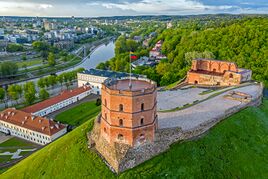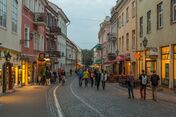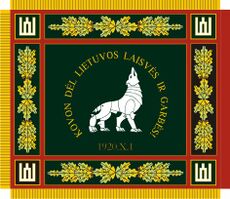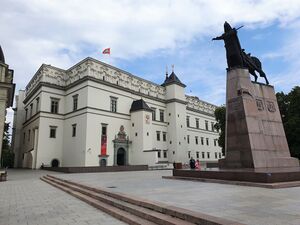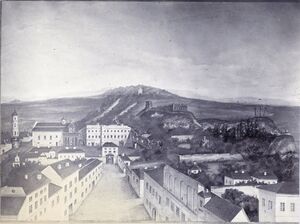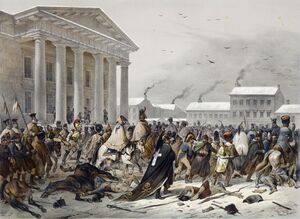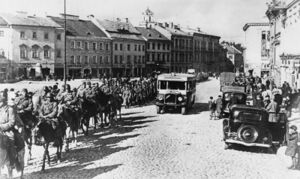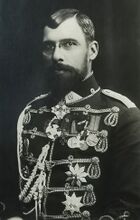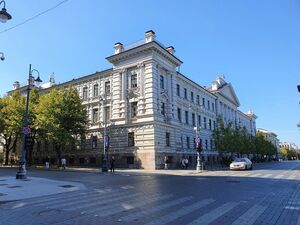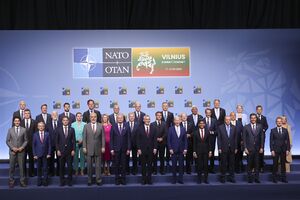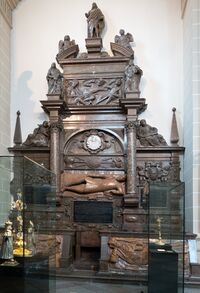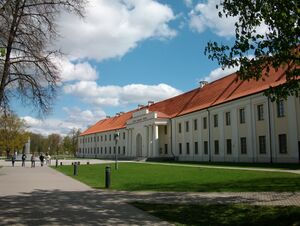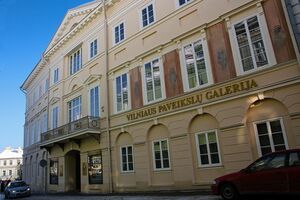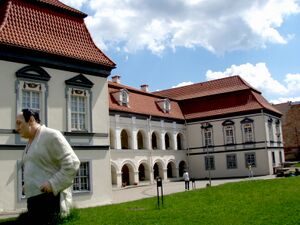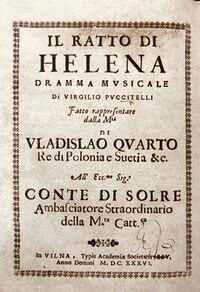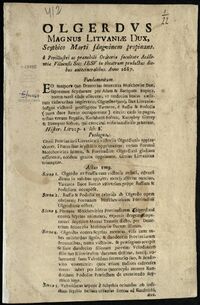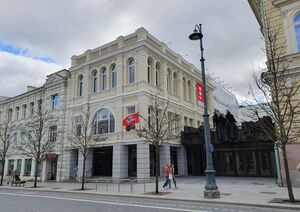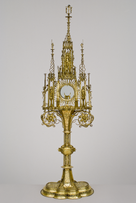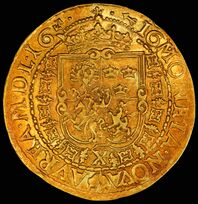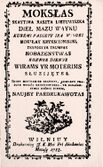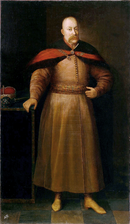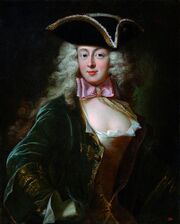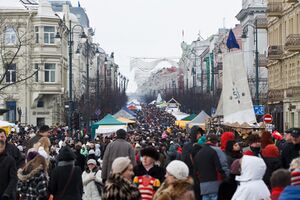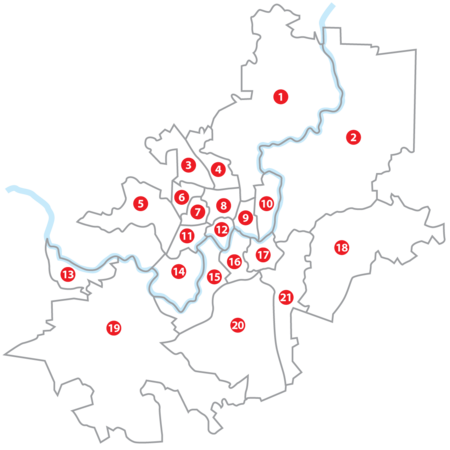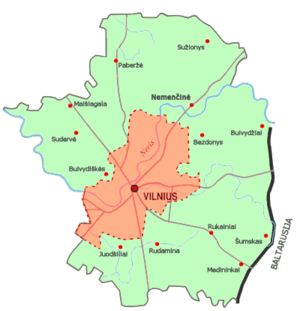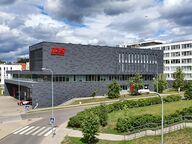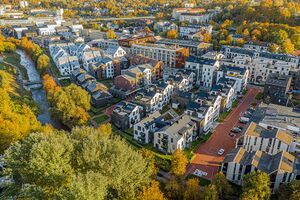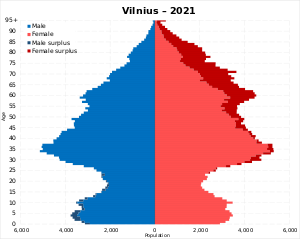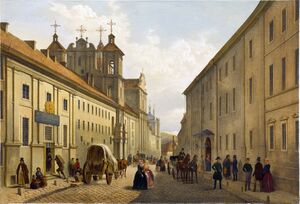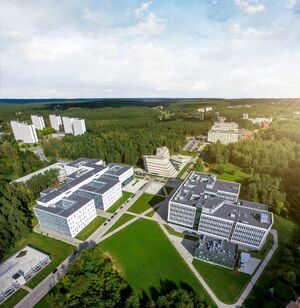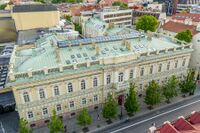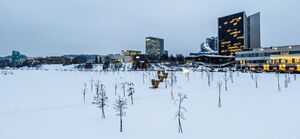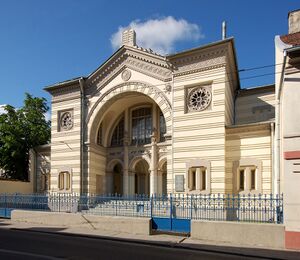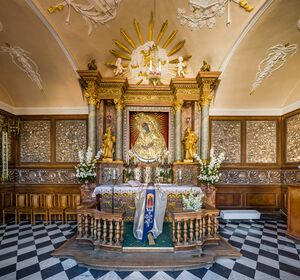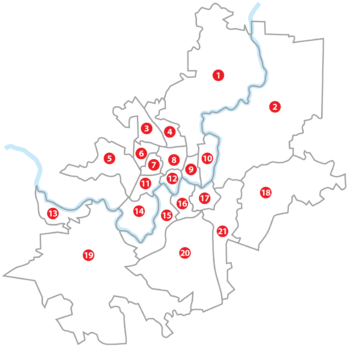ڤلنيوس
ڤلنيوس
Vilnius | |
|---|---|
Clockwise from top: Ruins of the Upper Castle, Vilnius business district, Presidential Palace, Pilies Street, Gate of Dawn, Vilnius Cathedral and its bell tower, Užupis | |
|
| |
| الكنية: | |
| الشعار: Unitas, Justitia, Spes (Latin: Unity, Justice, Hope) | |
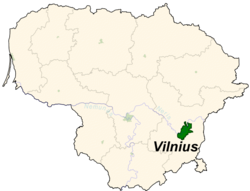 | |
| المنطقة العرقية | Aukštaitija |
| المقاطعة | مقاطعة ڤيلنيوس |
| بلدية | بلدية مدينة فيلنيوس |
| Capital of | Lithuania |
| First mentioned | 1323 |
| Granted city rights | 1387 |
| Elderships | |
| الحكومة | |
| • النوع | City council |
| • Mayor | Remigijus Šimašius |
| المساحة | |
| • عاصمة | 401 كم² (155 ميل²) |
| • العمران | 2٬530 كم² (980 ميل²) |
| المنسوب | 112 m (367 ft) |
| التعداد (2021)[9] | |
| • عاصمة | 592٬389[8] |
| • الترتيب | (31st in EU) |
| • الكثافة | 1٬392/km2 (3٬610/sq mi) |
| • Urban | 718٬507[7] |
| • العمرانية | 701٬337[6] |
| صفة المواطن | Vilnian |
| منطقة التوقيت | UTC+2 (EET) |
| • الصيف (التوقيت الصيفي) | UTC+3 (EEST) |
| Postal code | 01001–14191 |
| مفتاح الهاتف | (+370) 5 |
| GMP (nominal)[10] | 2020 |
| – Total | €21.1 billion |
| – Per capita | €25,600 |
| City budget | ~€1.0 billion[11] |
| HDI (2019) | 0.920[12] – very high |
| Climate | Dfb |
| الموقع الإلكتروني | vilnius |
| الاسم الرسمي | Historic Centre of Vilnius |
| النوع | Cultural |
| المعيار | ii, iv |
| التوصيف | 1994 (18th session) |
| الرقم المرجعي | [13] |
| UNESCO region | Europe |
ڤيلنيوس Vilnius هي عاصمة لتوانيا, يبلغ تعداد سكانها حوالي 540,000 نسمة في عام 2003. فيلنيوس عاصمة لتوانيا، وأكبر مدينة بها. تقع فيلنوس في الجنوب الشرقي من لتوانيا على ضفاف نهر نيرس. عدد السكان 591,066 نسمة. تعتبر فيلنيوس مركزًا صناعيًا وثقافيًا وتعليميًا مهمًا، إضافة إلى أنها مركز نقل. تشمل منتجاتها الكيميائيات والأثاث والمعدات الصناعية والورق والمنسوجات. تمر خطوط السكة الحديد به عبر المدينة ويوجد بها مطار. وقد أنُشئت جامعة كابسوكاس الحكومية في فيلنيوس عام 1579.
اشتهرت فيلنيوس بكنائسها القديمة وغيرها من المباني التي يرجع تاريخها إلى ما بين القرنين الخامس عشر والتاسع عشر. وبالمدينة أيضًا مبانٍ حديثة تم تشييدها بعد انتهاء الحرب العالمية الثانية عام 1945.
Vilnius is classified as a Gamma global city according to GaWC studies,[14] and is known for the architecture in its Old Town, declared a UNESCO World Heritage Site in 1994.[15] Before World War II, Vilnius was one of the largest Jewish centres in Europe. Its Jewish influence has led to its nickname "the Jerusalem of Lithuania". Napoleon called it "the Jerusalem of the North"[16] as he was passing through in 1812. In 2009, Vilnius was the European Capital of Culture, together with Linz, Austria.[17] In 2021, Vilnius was named among top-25 fDi's Global Cities of the Future – one of the most forward-thinking cities with the greatest potential in the World.[18]
أصل الاسم والأسماء الأخرى
The name of the city originates from the Vilnia River, from the Lithuanian for ripple.[19] The city has also had many derivative spellings in various languages throughout its history: Vilna was once common in English. The most notable non-Lithuanian names for the city include پولندية: Wilno, بالبيلاروسية: Вiльня (Vilnia), ألمانية: Wilna, باللاتڤية: [Viļņa] Error: {{Lang}}: text has italic markup (help), أوكرانية: Вільно (Vilno), باليديشية: ווילנע (Vilne). A Russian name from the time of the Russian Empire was Вильна (Vilna),[20][21] although Вильнюс (Vilnyus) is now used. The names Wilno, Wilna and Vilna were also used in older English-, German-, French- and Italian-language publications when the city was one of the capitals of the Polish–Lithuanian Commonwealth and an important city in the Second Polish Republic. The name Vilna is still used in Finnish, Portuguese, Spanish, and بالعبرية: וילנה. Wilna is still used in German, along with Vilnius.
The neighborhoods of Vilnius also have names in other languages, which represent the languages spoken by various ethnic groups in the area.
According to legend, Grand Duke Gediminas (c. 1275–1341) was hunting in the sacred forest near the Valley of Šventaragis, near where the Vilnia River flows into the Neris River. Tired after the successful hunt of a wisent, the Grand Duke settled in for the night. He fell soundly asleep and dreamed of a huge Iron Wolf standing on top a hill and howling as strong and loud as a hundred wolves. Upon awakening, the Duke asked the krivis (pagan priest) Lizdeika to interpret the dream. The priest told him,
"What is destined for the ruler and the State of Lithuania, is thus: the Iron Wolf represents a castle and a city which will be established by you on this site. This city will be the capital of the Lithuanian lands and the dwelling of their rulers, and the glory of their deeds shall echo throughout the world."
Therefore, Gediminas, obeying the will of the gods, built the city, and gave it the name Vilnius, from the Vilnia River.[22]
التاريخ
أنشأ الدوق الكبير جيديميناس فيلنوس في حوالي عام 1323. وقد سيطر الروس على المدينة في الفترة بين عامي 1795 – 1918. وأصبحت لتوانيا دولة مستقلة في عام 1918، لكن بولندا فرضت سيطرتها على المدينة في الفترة بين عامي 1920 – 1939، وهو العام الذي أعيدت فيه فيلنيوس إلى لتوانيا. وفي عام 1940، استولى الاتحاد السوفيتي على لتوانيا عنوةً فأصبحت جزءاً من البلاد. وفي عام 1991، انفصلت لتوانيا عن الاتحاد السوفيتي وأصبحت دولة مستقلة.
التاريخ المبكر وگراندوقية لتوانيا
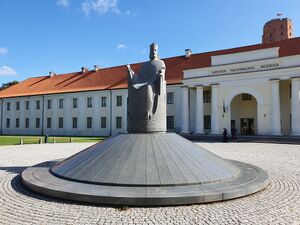
Historian Romas Batūra identifies the city with Voruta, one of the castles of Mindaugas, who was King of Lithuania after coronation in 1253. During the reign of Grand Dukes Butvydas and Vytenis, a city started emerging from a trading settlement and the first Franciscan Catholic church was built.[23]
Vilnius is the historic and present-day capital of Lithuania. Archeological findings indicate that this city was the capital of the Kingdom of Lithuania and later that of the Grand Duchy of Lithuania. After Lithuania formed a dual confederation with the Kingdom of Poland, Vilnius still remained as Lithuania's capital.[24]
The city was first mentioned in written sources in 1323 as Vilna,[25] when the Letters of Grand Duke Gediminas were sent to German cities inviting Germans (including German Jews) to settle in the capital city, as well as to Pope John XXII. These letters contain the first unambiguous reference to Vilnius as the capital;[24] Old Trakai Castle had been the earlier seat of the court of the گراندوقية لتوانيا.
Vilnius's location offered practical advantages: it lay in the Lithuanian heartland at the confluence of two navigable rivers (Vilnia and Neris), surrounded by impenetrable forests and wetlands.
At the time of the 14th century, Lithuania was continuously invaded by the Teutonic Order.[27] The future King of England Henry IV (then Henry Bolingbroke) spent a full year of 1390 supporting the unsuccessful siege of Vilnius by Teutonic Knights with his 300 fellow knights. During this campaign he bought captured Lithuanian women and children and took them back to Königsberg for their conversion.[28] King Henry's second expedition to Lithuania in 1392 illustrates the financial benefits of these guest crusaders to the Order. His small army consisted of over 100 men, including longbow archers and six minstrels, at a total cost to the Lancastrian purse of £4,360. Despite the efforts of Bolingbroke and his English crusaders, two years of attacks on Vilnius proved fruitless.[29]
Vilnius was the flourishing capital of the Grand Duchy of Lithuania, the residence of the Grand Duke. Gediminas expanded the Grand Duchy through warfare along with strategic alliances and marriages.[24] At its height it covered the territory of modern-day Lithuania, Belarus, Ukraine, Transnistria, and portions of modern-day Poland and Russia. His grandchildren Vytautas the Great and Jogaila, however, fought civil wars. During the Lithuanian Civil War of 1389–1392, Vytautas besieged and razed the city in an attempt to wrest control from Jogaila.[24] The two Gediminids cousins later settled their differences; after a series of treaties culminating in the 1569 Union of Lublin, the Polish–Lithuanian Commonwealth was formed. The Commonwealth's rulers held two titles: Grand Duke of Lithuania and King of Poland. In 1387, Jogaila acting as a Grand Duke of Lithuania and King of Poland, granted Magdeburg rights to the city.[24]
— Papal nuncio Berardo Bongiovanni recalling about Sigismund II Augustus's treasury kept in the Grand Ducal Palace in 1560.[30] Vilnius was Sigismund's favorite city, his investments made it one of the most beautiful cities in eastern and central Europe.[31]
الكومنولث الپولندي-اللتواني
Vilnius's growth was due in part to the establishment of Alma Academia et Universitas Vilnensis Societatis Iesu by the Polish King and Grand Duke of Lithuania Stephen Báthory in 1579. The university soon developed into one of the most important scientific and cultural centres in the region and the most notable scientific centre of the Commonwealth.[32]
During its rapid development, the city was open to migrants from the territories of the Crown of the Kingdom of Poland, the Grand Duchy and further. Many languages were spoken: Polish, German, Yiddish, Ruthenian, Lithuanian, Russian, Old Church Slavonic, Latin, Hebrew, and Turkic languages; the city was compared to Babylon.[33][34] Each group contributed uniquely to the city's life, and crafts, trade, and science prospered.
The 17th century brought a number of setbacks. The Commonwealth was involved in a series of wars, collectively known as The Deluge. During the Thirteen Years' War (1654–1667), Vilnius was occupied by Muscovite forces; it was pillaged and burned, and its population massacred.[34] During the Great Northern War it was looted by the Swedish army.[34] An outbreak of bubonic plague in 1710 killed about 35,000 residents; devastating fires occurred in 1715, 1737, 1741, 1748, and 1749.[35][34]
The city's growth lost its momentum for many years, but even despite this fact, at the end of the 18th century and before the Napoleon wars, Vilnius, with 56,000 inhabitants, entered the Russian Empire as its third-largest city.[34]
في الإمبراطورية الروسية
انهارت حظوظ الكومنولث في القرن الثامن عشر. فقد وقعت ثلاث تقاسمات، قسّمت أراضيه بين الإمبراطورية الروسية وإمبراطورية هابسبورگ ومملكة پروسيا. فطردت قوات بقيادة ياكوب ياسنسكي الروس من ڤلنيوس أثناء انتفاضة في 1794.[36] However, after the third partition of April 1795, Vilnius was annexed by the Russian Empire and in 1797–1801 was centre of the short-lived Lithuania Governorate, but since 1801 it become centre of the Vilna Governorate.[34] During Russian rule, the city walls were destroyed, and by 1805 only the Gate of Dawn remained.[34]
In 1807–1812 considerations took place, and the inhabitants of Vilnius and Lithuania expected Tsar Alexander I to grant them autonomy following the restoration of the Grand Duchy of Lithuania, which would have been subordinate to the tsar and a counterpoise for the Duchy of Warsaw; but the Grand Duchy of Lithuania was not restored as an autonomous subject.[37]
In 1812, the city was taken by Napoleon on his push towards Moscow, and again during the disastrous retreat.[34] Initially, the Grande Armée and Napoleon were welcomed in Vilnius as liberators with locals aspirations of restoring the Grand Duchy of Lithuania.[38] In response Napoleon established the Lithuanian Provisional Governing Commission.[34] Thousands of soldiers died in the city during the eventual retreat; the mass graves were uncovered in 2002.[39][34]
In 1814, the Congress of Vienna began which resulted in considerations to attach the Northwestern Krai (which included Vilnius) to Congress Poland, but it was not realized.[37] Soon the activity of Philomaths and Filarets and their trial resulted in tightened control over the region's culture and intensified Russification.[37]
Following the November Uprising in 1831, Vilnius University was closed and Russian repressions halted the further development of the city.[34] Civil unrest in 1861 was suppressed by the Imperial Russian Army.[40][34]
During the January Uprising in 1863, heavy fighting occurred within the city, but was brutally pacified by Mikhail Muravyov, nicknamed The Hangman by the population because of the many executions he organized. After the uprising, all civil liberties were withdrawn, and use of the Polish[41] and Lithuanian languages was banned.[42] Vilnius had a vibrant Jewish population: according to the Russian census of 1897, out of the total population of 154,500, Jews constituted 64,000 (approximately 40%).[43] During the early 20th century, the Lithuanian-speaking population of Vilnius constituted only a small minority, with Polish, Yiddish, and Russian speakers comprising the majority of the city's population.[44]قالب:Verify inline
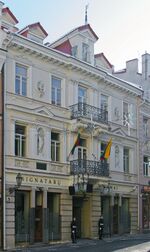
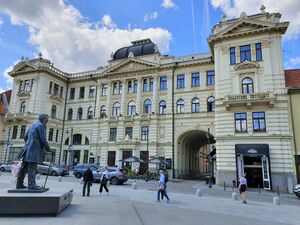
On 4–5 December 1905, the Great Seimas of Vilnius was held in the current Lithuanian National Philharmonic Society building with over 2000 participants. It was the first modern national congress in Lithuania.[45] The assembly decided to demand wide political autonomy within the Russian Empire and achieve this by peaceful means. It is considered an important step towards the Act of Independence of Lithuania, adopted on 16 February 1918 by the Council of Lithuania, as the Seimas laid the groundwork for the establishment of an independent Lithuanian state.[46]
الحرب العالمية الأولى
During World War I, Vilnius and the rest of Lithuania was occupied by the German Army from 1915 until 1918.[47] The Act of Independence of Lithuania, which declared Lithuanian independence without any affiliation to any other nation, was issued in the city on 16 February 1918 with Vilnius as its capital.[48]
الاضطرابات الإقليمية 1918–1920
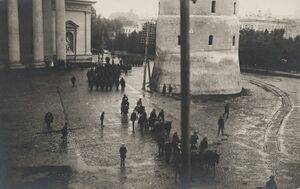
At the end of 1918 Soviet Russia invaded Lithuania with massive forces, and the Lithuanian Army withdrew from Vilnius to the center of the country in order to form a defense line. The German Army withdrew together with the Lithuanian government. The Self-Defence of Lithuania, which was affiliated with the Second Polish Republic, briefly controlled the city and unsuccessfully tried protecting it against the invading Soviet forces. Vilnius changed hands again during the Polish–Soviet War and the Lithuanian Wars of Independence: it was taken by the Polish Army, only to fall to Soviet forces again. Shortly after the Red Army's defeat at the 1920 Battle of Warsaw, in order to delay the Polish advance, the Soviet government ceded the city to Lithuania after signing the Soviet–Lithuanian Peace Treaty on 12 July 1920.[49]
The League of Nations became involved in the subsequent Lithuanian self defense from Poland after it attacked Lithuanian army positions in the southwest of Lithuania. The League brokered the ceasefire called the Suwałki Agreement on 7 October 1920. Lithuanians believed that it stopped a Polish aggression. Although neither Vilnius or the surrounding region was explicitly addressed in the agreement, numerous historians have described the agreement as allotting Vilnius to Lithuania.[50][51][52][53][54][55][56][57][58] On 9 October 1920, the Polish Army surreptitiously, under General Lucjan Żeligowski, seized Vilnius during an operation known as Żeligowski's Mutiny. The city and its surroundings were designated as a separate state, called the Republic of Central Lithuania.
پولندا بين الحربين
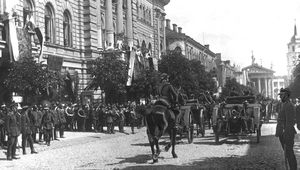
Vilnius University was reopened in 1919 under the name of Stefan Batory University.[60]
On 20 February 1922, after the highly contested election in Central Lithuania, the entire area was annexed by Poland, with the city becoming the capital of the Wilno Voivodeship (Wilno being the name of Vilnius in Polish). Kaunas then became the temporary capital of Lithuania. Lithuania vigorously contested the Polish annexation of Vilnius, and refused diplomatic relations with Poland. The predominant languages of the city were still Polish and, to a lesser extent, Yiddish. The Lithuanian-speaking population at the time was a small minority, at about 6% of the city's population according even to contemporary Lithuanian sources.[61] The Council of Ambassadors and the international community (with the exception of Lithuania) recognized Polish sovereignty over Vilnius Region in 1923.[62]
Subsequently, the Polish administration in the Vilnius Region carried out Lithuanian ethnocide.[63] The cultural assimilation policy intensified since 1936 when voivode Ludwik Bociański adopted a secret document targeted against Lithuanians which resulted in closure of almost all Lithuanian schools, reading rooms, organizations, while its members were imprisoned or deported.[64][65] Moreover, members of the Camp of National Unity, which had an absolute majority in the Sejm since 1938, suggested to tractate Belarusians as a constituent part of the Polish nation and to assimilate them.[66] Romuald Jałbrzykowski cooperated with Ludwik Bociański and prohibited Catholic Belarusians to be members of Belarusian societies, thus until World War II only one Belarusian society (Belarusian Beekeepers' Society) remained.[67]
By 1931, the city had 195,000 inhabitants, making it the fifth largest city in Poland with varied industries, such as Elektrit, a factory that produced radio receivers.
الحرب العالمية الثانية
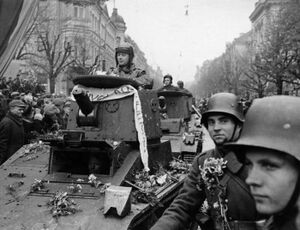
Nazi Germany had invited Lithuania to join the invasion of Poland and retake the historical capital Vilnius by force; however, President Antanas Smetona and most of the Lithuanian politicians declined this offer because they had doubts about Adolf Hitler's eventual victory and were outraged by the 1939 German ultimatum to Lithuania. Instead, they supported the neutrality policy and after being encouraged by the French and British diplomats – Lithuania adopted the Neutrality Act, which was supported by all the political forces.[68]
World War II began with the German invasion of Poland in September 1939. The secret protocols of the Molotov–Ribbentrop Pact had partitioned Lithuania and Poland into German and Soviet spheres of interest. On 19 September 1939, Vilnius was seized by the Soviet Union (which invaded Poland on 17 September). The Soviets repressed the local population and devastated the city, moving assets and factories to the USSR territory, including the major Polish radio factory Elektrit, along with a part of its labor force, to Minsk in Belarus SSR.[69] The Soviets and Lithuania concluded a mutual assistance treaty on 10 October 1939, with which the Lithuanian government accepted the presence of Soviet military bases in various parts of the country. On 28 October 1939, the Red Army withdrew from the city to its suburbs (to Naujoji Vilnia) and Vilnius was given over to Lithuania. A Lithuanian Army parade took place on 29 October 1939 through the city center. The Lithuanians immediately attempted to re-Lithuanize the city, for example by Lithuanizing Polish schools.[70]
Following the normalisation of relation with Poland the Lithuanian Consulate was opened in Vilnius on 22 August 1939, but the consul started operating there only after the war already began, on 9 September 1939.[71]
The whole of Lithuania was annexed by the Soviet Union on 3 August 1940, following a June ultimatum from the Soviets demanding, among other things, that unspecified numbers of Red Army soldiers be allowed to enter the country for the purpose of helping to form a more pro-Soviet government. After the ultimatum was issued and Lithuania further occupied, a Soviet government was installed with Vilnius as the capital of the newly created Lithuanian SSR. Between 20,000 and 30,000 of the city's inhabitants were subsequently arrested by the NKVD and sent to gulags in the far eastern areas of the Soviet Union.[72]
On 22 June 1941, the Germans launched Operation Barbarossa against the Soviet Union, while at the same time Lithuanians began the anti-Soviet June Uprising, organized by the Lithuanian Activist Front. Lithuanians proclaimed independence and organized the Provisional Government of Lithuania. This government quickly self-disbanded.[73] Nazis captured Vilnius on 24 June 1941.[74] Lithuania became part of the Reichskommissariat Ostland, German civil administration.[75] Two ghettos were set up in the old town centre for the large Jewish population – the smaller one of which was "liquidated" by October.[76] The larger ghetto lasted until 1943, though its population was regularly deported in roundups known as "Aktionen".[77] A forced labour camp (Kailis) was also set up behind the Vilnius Town Hall as a factory to produce winter clothing for the Wehrmacht and another one later for vehicle repair (HKP 562) on 47 & 49 Subačiaus Street. A failed ghetto uprising on 1 September 1943 organized by the Fareinigte Partizaner Organizacje (the United Partisan Organization, the first Jewish partisan unit in German-occupied Europe),[78] was followed by the final destruction of the ghetto. During the Holocaust, about 95% of the 265,000-strong Jewish population of Lithuania was murdered by the German units and Lithuanian Nazi collaborators, many of them in Paneriai, about 10 km (6.2 mi) west of the old town centre (see the Ponary massacre).
Vilnius' situation in 1944 was tenuous. As the Eastern Front neared Lithuania, the Lithuanian Territorial Defense Force (LTDF) under general Plechavičius was founded in mid-February to fight the Red Army and Soviet partisans, both only within Lithuanian borders, but it was soon brutally disbanded in mid-April by the Germans due to German-Lithuanian friction. As Armia Krajowa (AK) operated within the borders of interwar Poland, which overlapped with the Lithuanian lands, this caused clashes between both organisations. In early July, Operation Ostra Brama was a failed attempt of the AK to take the city from the Wehrmacht before the approaching Red Army.[79] As the Polish army did not take over the city, the speed of the Soviet Vilnius offensive led to a joint Polish-Soviet effort to seize Vilnius. After the battle, the Polish army was dispersed, some of it incorporated into the Soviet-loyal Polish People's Army, while the officers were arrested and imprisoned.[بحاجة لمصدر]
الاحتلال السوڤيتي
In July 1944, Vilnius was once more occupied by Soviet Army with the Vilnius offensive, during which it defeated the German garrison.[80] The town was once more the Lithuanian SSR's capital. The NKVD began repressions against Lithuanians and Poles.[81][82] Sovietization began in earnest.
The war had irreversibly altered the city – between 1939 and 1949, Vilnius lost almost 90% of its population, through murder, deportation or exile, many buildings were destroyed.[83] The Jewish population had been exterminated in the Holocaust, while most of the remaining ones were compelled to move to Communist Poland by 1946. Some partisans and members of the intelligentsia hiding in the forest were now targeted and deported to Siberia after the war.[بحاجة لمصدر]
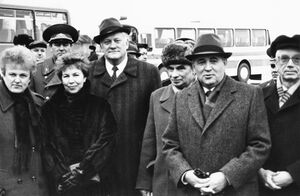
From the late 1940s onward Vilnius began to grow again, following an influx of Lithuanians, Poles and Belarusians from neighbouring regions and throughout Lithuania as well as neighbouring region of Grodno and from other more remote areas of the Soviet Union (particularly Russia, Belarus and Ukraine).[بحاجة لمصدر] Most of these new residents moved to Vilnius, due to repressions or poor living conditions caused by, e.g. collectivisation, in areas, where they lived previously.[85][86] On the previously rural outskirts as well as in the very vicinity of the Old Town (industrial zones in Paupys, Markučiai, Naujamiestis), industrial areas were (re)designed and large Soviet plants were built, following a program of industrialization.[34]
In November 1980, the number of inhabitants of Vilnius exceeded 500,000. Because of shortage of housing for a growing population of the city, large scale Microdistricts (so-called sleeping districts) were built in the elderates of Antakalnis, Žirmūnai, Lazdynai, Karoliniškės, Viršuliškės, Baltupiai, Šeškinė, Justiniškės, Pašilaičiai, Fabijoniškės and on a smaller scale in other parts of Vilnius.[24][34] These were connected with the central part as well as with industrial areas via expressway-like streets (so-called fast traffic streets) and by public transport, noticeably extensive network of trolleybuses (from 1956).[87]
Vilnius was a centre of Lithuanian dissidents and in 1978 the Lithuanian Liberty League was established.[34]
لتوانيا المستقلة

On 11 March 1990, the Supreme Council of the Lithuanian SSR announced its secession from the Soviet Union and intention to restore an independent Republic of Lithuania.[88] As a result of these declarations, on 9 January 1991, the Soviet Union sent in troops. This culminated in the 13 January attack on the State Radio and Television Building and the Vilnius TV Tower, killing at least fourteen civilians and seriously injuring 700 more.[89] The Soviet Union finally recognised Lithuanian independence in September 1991.[90] The Constitution, as did the earlier Lithuanian Constitution of 1922, mentions that "the capital of the State of Lithuania shall be the city of Vilnius, the long-standing historical capital of Lithuania".
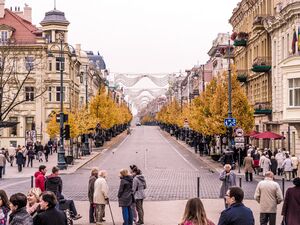
Vilnius has been rapidly transforming, emerging as a modern European city. The majority of its historical buildings during the last 25 years had been renovated, and a business and commercial area is being developed into the New City Centre, that is expected to become the city's main administrative and business district on the north side of the Neris river. This area includes modern residential and retail space, with the municipality building and the 148.3 m (487 ft) Europa Tower as its most prominent buildings. The construction of Swedbank's headquarters is symbolic of the importance of Scandinavian banks in Vilnius. The building complex Vilnius Business Harbour was built in 2008, and one of its towers is now the 6th tallest building in Lithuania. More buildings are scheduled for construction in the area. More than 75,000 new flats were built between 1995 and 2018 (including almost 50,000 new flats between 2003 and 2018), making Vilnius an absolute leader in construction sector in the Baltics of the last two decades. On average, 298،000 m2 (3،210،000 sq ft) or 3,246 flats are built each year. In 2015, there were 225,871 units in multi-storey houses and 20,578 flats in single-family or duplex apartment houses, the share of such housing increasing from 6.9% in 2006 to 8.3% in 2015.[91][92] The record numbers of flats were built in 2019 – 4,322 flats in multi-family residentials were built in Vilnius city municipality and 817 flats were built in Vilnius urban zone (the city and the closest surroundings) in single-family detached houses – the later being the highest number in history.[93]
Vilnius was selected as a 2009 European Capital of Culture, along with Linz, the capital of Upper Austria. Its 2009 New Year's Eve celebration, marking the event, featured a light show said to be "visible from outer space".[94] In preparation, the historical centre of the city was restored, and its main monuments were renovated.[95]
The global economic crisis of 2007–2008 led to a drop in tourism which prevented many of the projects from reaching their planned extent, and allegations of corruption and incompetence were made against the organisers,[96][97] while tax increases for cultural activity led to public protests[98] and the general economic conditions sparked riots.[99] In 2015 Remigijus Šimašius became the first directly elected mayor of the city.[100]
On 28–29 November 2013, Vilnius hosted the Eastern Partnership Summit in the Palace of the Grand Dukes of Lithuania. Many European presidents, prime ministers and other high-ranking officials participated in the event.[101] On 29 November 2013, Georgia and Moldova signed association and free trade agreements with the European Union.[102] Previously, Ukraine and Armenia were also expected to sign the agreements but postponed the decision, sparking large protests in Ukraine.
The 2023 NATO summit was held in Vilnius.[103]
الجغرافيا
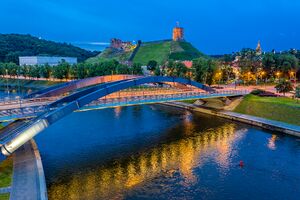
Vilnius is situated in southeastern Lithuania at the confluence of the Vilnia and Neris rivers. Several countries claim that the geographical centre of Europe is located in their territories. Its location depends on which arbitrary definition of the extent of Europe is chosen; the Guinness Book of World Records recognises a point near Vilnius as the continent's centre.[104] After a re-estimation of the boundaries of the continent in 1989, Jean-George Affholder, a scientist at the Institut Géographique National (French National Geographic Institute) determined that its geographic centre was located at 54°54′N 25°19′E / 54.900°N 25.317°E.[105] The method used for calculating this point was that of the centre of gravity of the geometrical figure of Europe. This point is located in Lithuania, near the village of Girija (26 kilometres from Vilnius). A monument, composed by the sculptor Gediminas Jokūbonis and consisting of a column of white granite surmounted by a crown of stars, was erected at the location in 2004.[104]
Vilnius lies 312 km (194 mi) from the Baltic Sea and Klaipėda, the chief Lithuanian seaport. Vilnius is connected by highways to other major Lithuanian cities, such as Kaunas (102 km أو 63 mi away), Šiauliai (214 km أو 133 mi away) and Panevėžys (135 km أو 84 mi away).
The area of Vilnius is 402 km2 (155 sq mi). Buildings occupy 29.1% of the city; green spaces occupy 68.8%; and waters occupy 2.1%.[106]
المحميات الطبيعية
Vilnius has eight protected nature reserves: Vokės Senslėnio Slopes Geomorphological Reserve, Aukštagiris Geomorphological Reserve, Valakupių Klonio Geomorphological Reserve, Veržuva Hydrographic Reserve, Vokė Hydrographic Reserve, Cedronas Upstream Landscape Reserve, Tapeliai Landscape Reserve and Šeškinė Slopes Geomorphological Reserve.[107]
المناخ

The climate of Vilnius is humid continental (Köppen climate classification Dfb).[108] Temperature records have been kept since 1777.[109] The average annual temperature is 7.3 °C (45 °F); in January the average temperature is −3.9 °C (25 °F), in July it is 18.7 °C (66 °F). The average precipitation is about 691 mm (27.20 in) per year. Average annual temperatures in the city have increased significantly during the last 30 years, a change which the Lithuanian Hydrometeorological Service attributes to global warming induced by human activities.[110]
Summer days are warm and sometimes hot, especially in July and August, with temperatures above 30 °C (86 °F) throughout the day during periodic heat waves. Outdoor bars, restaurants and cafés are widely frequented during the daytime.
Winters can be very cold, with temperatures rarely reaching above freezing – temperatures below −25 °C (−13 °F) may occur in January and February. Vilnius's rivers freeze over in particularly cold winters, and the lakes surrounding the city are almost always permanently frozen during this time of year. A popular pastime is ice-fishing.[بحاجة لمصدر]
The Lithuanian Hydrometeorological Service is headquartered in Vilnius and monitors climate of Vilnius and Lithuania.[111]
| متوسطات الطقس لڤلنيوس، ليتوانيا | |||||||||||||
|---|---|---|---|---|---|---|---|---|---|---|---|---|---|
| شهر | يناير | فبراير | مارس | أبريل | مايو | يونيو | يوليو | أغسطس | سبتمبر | اكتوبر | نوفمبر | ديسمبر | السنة |
| متوسط العظمى °م (°ف) | -3.5 (25.7) | -1.7 (28.9) | 3.3 (37.9) | 10.7 (51.3) | 18.2 (64.8) | 21.1 (70) | 22.1 (71.8) | 21.6 (70.9) | 16.4 (61.5) | 10.2 (50.4) | 3.5 (38.3) | -0.5 (31.1) | 10٫1 (50٫2) |
| متوسط الصغرى °م (°ف) | -8.7 (16.3) | -7.6 (18.3) | -3.8 (25.2) | 1.6 (34.9) | 7.5 (45.5) | 10.8 (51.4) | 12.3 (54.1) | 11.5 (52.7) | 7.7 (45.9) | 3.4 (38.1) | -0.9 (30.4) | -5.2 (22.6) | 3٫4 (36٫4) |
| هطول الأمطار mm (بوصة) | 41 (1.61) | 38 (1.49) | 39 (1.53) | 46 (1.81) | 62 (2.44) | 77 (3.03) | 78 (3.07) | 72 (2.83) | 65 (2.56) | 53 (2.09) | 57 (2.24) | 55 (2.17) | 683 (26٫9) |
| المصدر: The World Meteorological Organization[112] Nov 2006 | |||||||||||||
Culture
Painting and sculpture
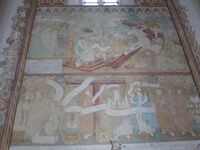
For centuries, Vilnius was an art centre of the Grand Duchy of Lithuania and has attracted artists from across Europe. The oldest works of art which remained from the early Gothic period (14th century) are paintings dedicated to churches and liturgy (e.g. frescoes in the Crypts of Vilnius Cathedral, decorated hymns books). Wall paintings from the 16th century, such as the paintings in the Church of St. Francis and St. Bernard vaults or in the Church of Saint Nicholas, were found in Vilnius.[113] Gothic wooden polychrome sculptures were used to decorate the altars of the churches of Vilnius. Some Gothic seals from the 14–15th centuries in Vilnius even remain until the present day, including those of Kęstutis, Vytautas the Great and Sigismund II Augustus.[114]
In the early 16th century, Renaissance sculptures appeared, which were mostly created by Italian sculptors: Bernardinus Zanobi da Gianotti, Giovani Cini, Giovanni Maria Padovano. In the Renaissance period, portrait tombstones and medals were highly valued (e.g. marble tombs of Albertas Goštautas, 1548, and of Paweł Holszański, 1555, by Bernardino de Gianotis, both located in the Vilnius Cathedral). The works of Italian sculptors are characterized by a naturalistic treatment of forms, precise proportions, tectonicity, a realistic representation of the deceased. The local sculptors took over only the iconographic scheme of the Renaissance tomb; their works (e.g. tomb of Lew Sapieha, ca. 1633, at Church of St. Michael) are characterized by conditionality of forms, stylization.[114] During this period local and Western European painters created religious, mythologic compositions, portraits, which were intertwined with late Gothic and Baroque features. Illustrated prayer books illustrations and miniatures have survived.[113]
The Baroque period which began in the late 16th century was exceptional for Vilnius as wall painting blossomed in the city. Most of the palaces and churches were decorated with frescoes characterized by bright colors, sophisticated angles and dramatism style. Also during this period, secular painting spread – representational, imaginative, epitaph portraits, scenes of battles, politically important events. It is characterized by detailed realistic style.[113] This period sculptures dominated in the sacred architecture (tombstones with sculptural portraits, exterior and interior decorative sculptures), made of wood, marble and stucco. Italian sculptors (e.g. G. P. Perti, G. M. Galli, A. S. Capone) were exceptionally important in the development of sculpture in the Grand Duchy in the 17th century, and were invited there by the Lithuanian nobility. Their works are characterized by the features of mature baroque: expressiveness of forms, sensuality, atectonic composition (e.g. sculptural decor of the Church of St. Peter and St. Paul). The local sculptors emphasized the decorative features of the baroque, and the expressiveness and emotionality of the baroque was less characteristic in their works.[114]
At the late 18th and 19th centuries, Lithuanian painting was largely influenced by the Vilnius Art School, which introduced manifestations of Classicism art and later of Romanticism art. The painters had internships abroad, mainly in Italy. Painting of allegorical, mythological compositions, landscapes, portraits of representatives of various circles of society was begun; historical themes prevailed. The most famous Classicism painters from this time are Franciszek Smaglewicz, Jan Rustem, Józef Oleszkiewicz, Daniel Kondratowicz, Józef Peszka, Wincenty Smokowski. While Romanticism art is characterized by Jan Rustem, Jan Krzysztof Damel, Wincenty Dmochowski and Kanuty Rusiecki works.[113] After the closure of Vilnius University in 1832, the artistic direction formed by the representatives of the Vilnius Art School influenced the further development of Lithuanian art.[115]
Development of art in the first half of the 20th century was promoted by activities and exhibitions of the Lithuanian Art Society, established in 1907 by Petras Rimša, Antanas Žmuidzinavičius, Antanas Jaroševičius, and Vilnius Art Society, established in 1908.[116][117] This period is characterized by Jonas Šileika, Justinas Vienožinskis, Jonas Mackevičius (1872), Vytautas Kairiūkštis, Vytautas Pranas Bičiūnas works. They continued the traditions of Western European styles (symbolism, realism, art nouveau) and followed the modernism art directions.[113] Although, after the World War II the method of socialist realism was introduced – propaganda paintings, compositions of historical, household genre, still lifes, landscapes, portraits and sculptures.[113][114]
The most notable late 20th and 21st centuries Vilnian painters are Žygimantas Augustinas, Eglė Ridikaitė, Eglė Gineitytė, Patricija Jurkšaitytė, Jurga Barilaitė, Solomonas Teitelbaumas.[113]
The Užupis district near the Old Town, which used to be one of the more run-down districts of Vilnius during the Soviet era, is home to a movement of bohemian artists, who operate numerous art galleries and workshops. Užupis declared itself an independent republic on April Fool's Day in 1997.[118] In the main square, the statue of an angel blowing a trumpet stands as a symbol of artistic freedom.
In 1995, the world's first bronze cast of Frank Zappa[119] was installed in the Naujamiestis district with the permission of the government. The Frank Zappa sculpture confirmed the newly found freedom of expression and marked the beginning of a new era for Lithuanian society.
In 2015, the project of Vilnius Talking Statues was realized. Eighteen statues around Vilnius interact with visitors in multiple languages by a telephone call to a smartphone.[120]
Museums and galleries
Vilnius has many museums of different kinds.[121] The National Museum of Lithuania has departments in the Palace of the Grand Dukes of Lithuania, Gediminas' Tower, old and new arsenals of the Vilnius Castle Complex and exhibits expositions about the history of Lithuania and Lithuanian ethnic culture.[122][123][124] The Museum of Applied Arts and Design exhibits Lithuanian folk sacral and other religious artworks, findings of the Palace of the Grand Dukes of Lithuania, authentic clothing from the 18th–20th centuries and held temporary exhibitions.[125] Other notable museums include Vilnius Museum, House of Histories exhibition space, Church Heritage Museum, Museum of Occupations and Freedom Fights, Fight for Freedom Museum in the Vilnius TV Tower, M. K. Čiurlionis House, Samuel Bak Museum, Centre for Civil Education, Toy Museum, Vilnil (Museum of Illusions), Energy and Technology Museum, House of Signatories, Tolerance Center, Railway Museum, Money Museum, Kazys Varnelis House-Museum, Liubavas Manor Watermill-Museum, Museum of Vladislovas Sirokomlė, Amber Museum – Gallery, Visitors Information Centre of the Paneriai Memorial, etc.[121][126]
Many prominent art galleries are located in Vilnius. Lithuania's largest art collection is housed in the Lithuanian Art Museum.[127] One branch of it, the Vilnius Picture Gallery in the Vilnius Old Town, houses a collection of Lithuanian art from the 16th to the beginning of the 20th century.[128] On the other side of the Neris, the National Art Gallery holds a permanent exhibition on Lithuanian 20th-century art, as well as numerous exhibitions on modern art.[129] The Contemporary Art Centre is the largest venue for contemporary art in the Baltic States, with an exhibition space of 2400 square meters. The centre is a non-collection based institution committed to developing a broad range of international and Lithuanian exhibition projects as well as presenting a wide range of public programmes including lectures, seminars, performances, film and video screenings, and live new music events.[130] On 10 November 2007, the Jonas Mekas Visual Arts Center was opened by avant-garde filmmaker Jonas Mekas with its premiere exhibition entitled The Avant-Garde: From Futurism to Fluxus.[131] In 2018, the MO Museum was opened and is a personal initiative of Lithuanian scientists and philanthropists Danguolė and Viktoras Butkus. Its collection of 5000 modern and contemporary pieces contains major Lithuanian artworks from the 1950s to this day.[132]
Literature
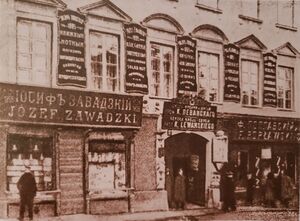
About 1520, Francysk Skaryna, who is the author of the first Ruthenian Bible, established a printing house in Vilnius – the first in eastern Europe. In 1522, he prepared and published the first printed book of the Grand Duchy of Lithuania, titled the Little Traveller's Book (Ruthenian language: Малая подорожная книжка). In 1525, he printed the Acts and Epistles of the Apostles (the Apostle).[133]
The Vilnius Academy Press was established in 1575 by the Lithuanian noble Mikołaj Krzysztof "the Orphan" Radziwiłł as the printing house of the Vilnius Academy. He delegated the management of the printing house to the Jesuits. In May 1576, it published its first book Pro Sacratissima Eucharistia contra haeresim Zwinglianam by Piotr Skarga. The Vilnius Academy Press situation was exceptional because its activities were funded by the secular society, the Lithuanian nobility and the Church.[134] In 1805, Józef Zawadzki bought the Vilnius Academy Press and founded the Józef Zawadzki printing shop which continuously worked until 1939 and published books in multiple languages.[135] The first poetry book of Adam Mickiewicz was published there in 1822.[136]
One of the creators of Lithuanian writing, Mikalojus Daukša, translated and published the Catechism by Spanish Jesuit theologist Jacobo Ledesma in 1595 – this was the first printed Lithuanian language book in the Grand Duchy of Lithuania. He also translated and published Jakub Wujek's Postilla Catholica in 1599 (both in Vilnius).[137]
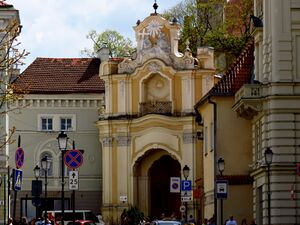
Many famous writers were born in Vilnius, lived there, or are alumni of Vilnius University (e.g. Konstantinas Sirvydas, Maciej Kazimierz Sarbiewski, Antoni Gorecki, Józef Ignacy Kraszewski, Antoni Edward Odyniec, Michał Józef Römer, Adam Mickiewicz, Władysław Syrokomla, Józef Mackiewicz, Romain Gary, Juliusz Słowacki, Simonas Daukantas, Mykolas Biržiška, Petras Cvirka (who was killed in Vilnius by soviet secret police), Kazys Bradūnas, Nobel prize-winner Czesław Miłosz, Jurga Ivanauskaitė).[138]
The first consideration of the First Statute of Lithuania took place in 1522 at the Seimas of the Grand Duchy of Lithuania in Vilnius. The Statute of Lithuania has been drafted under the guidance of Grand Chancellor of Lithuania Albertas Goštautas and in accordance with the courts' jurisprudence formed by customary law, Heads of State legislation on certain matters and by the provisions of the canon law and Roman law regulations. It is the first official codification of this kind of secular law in Europe.[139]
Lithuanian magnate Albertas Goštautas actively supported the Lithuanian language usage in the Lithuanian literature and protected Lithuanian authors, including Abraomas Kulvietis and Michael the Lithuanian, who criticised the usage of Old Slavonic church language and called refugees Old Believers as the Muscovian spies in his book De moribus tartarorum, lituanorum et moscorum.[140]
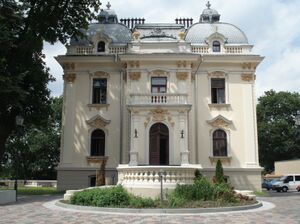
Since the 16th century, the Lithuanian Metrica was kept at the Lower Castle and safeguarded by the State Chancellor. Due to the deterioration of the books, the State Grand Chancellor, Lew Sapieha, ordered the volumes of the Metrica to be recopied in 1594. The recopying process continued until 1607. The newly recopied books were inventoried, rechecked, and transferred to a separate building in Vilnius, with the older books remaining in the Castle of Vilnius. According to the 1983 data, 665 books have remained until the nowadays and their microfilms are preserved at the Lithuanian State Historical Archives in Vilnius.[141]
Over 200 tiles and commemorative plaques to writers, who have lived and worked in Vilnius, and foreign authors, who have shared a connection with Vilnius and Lithuania, adorn walls on Literatų Street (لتوانية: Literatų gatvė) in the Old Town, presenting a broad overview of the history of Lithuanian literature.[142]
The Institute of Lithuanian Literature and Folklore and the Lithuanian Writers' Union are located in Vilnius.[143][144]
The Vilnius book fair, the biggest book fair in the Baltic states, is annually held in Vilnius at LITEXPO, the Baltic's biggest exhibition centre.[145]
Cinema
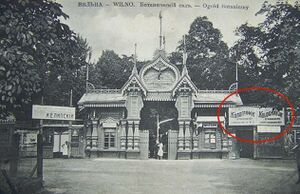
The first public film session in Vilnius was held in the Botanical Garden (now Bernardinai Garden) in July 1896. This event was held after some of the first film sessions by Auguste and Louis Lumière, held in Paris in 1895. The film session in Vilnius also showed the Lumière brothers' documentary movies. The first movies shown were educational; these were filmed in locations outside of Vilnius (e.g. India, Africa) and introduced different cultures to Vilnians. Georges Méliès' movie A Trip to the Moon was first shown in the non-stationary Lukiškės Square movie theater in 1902; it was the first feature film shown in Vilnius.[146]
The first stationary movie theater in Vilnius, named Iliuzija (إنگليزية: Illusion), was opened in 1905 and was located in Didžioji Street 60.[147] The first movie theaters were similar to theatre buildings and had boxes with more expensive tickets. Also, because there was no sound in the first movies, the sessions were accompanied by live orchestra performances. On stage, cinema screening was sometimes mixed with theatrical performances, illusion shows.[146]
On 4 June 1924, the Vilnius Magistrate established a popular 1,200-seat movie theater in the city hall, which in Polish was called Miejski kinematograf (إنگليزية: City Movie Theater). The purpose of this cinema was to provide cultural education for students and adults. In 1926, 502,261 tickets were sold and 24,242 tickets were given free to boarding children, and 778 tickets were given to tourists and 8,385 to soldiers. In 1939, the Lithuanian authorities renamed it to Milda. In 1940, the last city government handed over the premises to the People's Commissariat of Education, which established the Lithuanian National Philharmonic Society there.[147]
In 1965, the most modern movie theater in Lithuania called Lietuva was opened in Vilnius, which annually had over 1.84 million visitors and profit of over 1 million roubles. After the reconstruction, it had one of the largest screens in Europe (200 square metres).[147] It was closed in 2002, demolished in 2017. Eventually, MO Museum was built in its place.[148]
Kino Pavasaris is the largest film festival in Vilnius.[149]
The Lithuanian Film Centre (Lithuanian: Lietuvos kino centras), whose main task is to promote the development and competitiveness of the Lithuanian film industry, has its headquarters in Vilnius.[150]
Music
Musicians were presented at the Palace of the Grand Dukes of Lithuania as early as the 14th century, as Grand Duke Gediminas' daughter Aldona of Lithuania was known to be enthusiastic about music. Aldona took court musicians and singers with her to Kraków after marrying King Casimir III the Great.[152] In the 16th century, composers such as Wacław of Szamotuły, Jan Brant, Heinrich Finck, Cyprian Bazylik, Alessandro Pesenti, Luca Marenzio, and Michelagnolo Galilei lived in Vilnius at some point of their lives. Vilnius was also home to lutenist virtuoso Bálint Bakfark. One of the first local musicians known from written sources was Steponas Vilnietis (Stephanus de Vylna). The first textbook of Lithuanian music – The Art and Practice of Music (لاتينية: Ars et praxis musica) – was issued in Vilnius by Žygimantas Liauksminas in 1667.[153]
Italian artists organized the first opera in Lithuania on 4 September 1636 at the Palace of the Grand Dukes by the order of Grand Duke Władysław IV Vasa.[154] Currently, operas are staged at the Lithuanian National Opera and Ballet Theatre and also by independent troupe Vilnius City Opera.[155]
The Lithuanian National Philharmonic Society is the largest and oldest state owned concert organization in Lithuania, who organizes and coordinates live concerts and tours throughout Lithuania and abroad.[156] The Lithuanian State Symphony Orchestra, founded by Gintaras Rinkevičius, also performs in Vilnius.[157]
In Lithuania, choral music is very important. Vilnius is the only city with three choir laureates (Brevis, Jauna Muzika and Chamber Choir of the Conservatoire) at the European Grand Prix for Choral Singing.[158] Also, Dainų šventė (Lithuanian Song and Dance Festival), is a longstanding tradition in Vilnius. Since 1990, the festival has been organised every four years and summons roughly 30,000 singers and folk dancers of various professional levels and age groups from across the country in Vingis Park.[159] In 2008, the Lithuanian Song and Dance Festival, along with its Latvian and Estonian counterparts, was inscribed as UNESCO Masterpiece of the Oral and Intangible Heritage of Humanity.[160]
The jazz scene was known to be quite active in Vilnius. In 1970–71, the Ganelin/Tarasov/Chekasin trio would found Vilnius Jazz School.[161] The most known annual event of jazz in the city is the Vilnius Jazz Festival.

Gatvės muzikos diena (Street Music Day) gathers musicians of various genres annually in the streets of Vilnius.[162]
Vilnius is the birthplace of many prominent music personalities: singers (e.g. Mariana Korvelytė – Moravskienė, Paulina Rivoli, Danielius Dolskis, Vytautas Kernagis, Algirdas Kaušpėdas, Andrius Mamontovas, Nomeda Kazlaus, Asmik Grigorian), composers (e.g. César Cui, Felix Yaniewicz, Maximilian Steinberg, Vytautas Miškinis, Onutė Narbutaitė), conductors (e.g. Mirga Gražinytė-Tyla), musicians (e.g. Antoni Radziwiłł, Jascha Heifetz, Clara Rockmore, Romas Lileikis).
Vilnius was a hometown of 18th century composers as Michał Kazimierz Ogiński, Johann David Holland (colleague of C. Bach), Maciej Radziwiłł, Michał Kleofas Ogiński. 19th century Vilnius was famous for performers as singer Kristina Gerhardi Frank – a close friend of Mozart and Haydn (performed the main part at the premiere of The Creation by the latter), guitarist-virtuoso Marek Konrad Sokołowski, recognized as the best guitarist in Europe in the mid-19th century, and composer Stanisław Moniuszko – "the father of Polish national opera". The wealthiest woman in the early 19th century Vilnius was singer Maria de Neri. In the early 20th century, Vilnius was a hometown of Mikalojus Konstantinas Čiurlionis, Mikas Petrauskas, Juozas Tallat-Kelpša. Musicians of late 20th and early 21st centuries include Vyacheslav Ganelin, Petras Vyšniauskas, Petras Geniušas, Mūza Rubackytė, Alanas Chošnau, Marijonas Mikutavičius.
The Lithuanian Academy of Music and Theatre is headquartered in Gediminas Avenue and also has its department at the Slushko Palace in Antakalnis. Many accomplished singers have lectured at the academy, including the internationally famous tenors Kipras Petrauskas and Virgilijus Noreika.[163]
Theatre
Lithuanian Grand Dukes' entertainment at the castle, ruler's visits abroad and the honorable guests' arrival meetings etiquette had theatrical elements already since the 14th century (e.g. musicians' chapels of Gediminas and Władysław II Jagiełło). During the period of Sigismund III Vasa's residence in Vilnius (first half of the 17th century), English professional drama actors' troupes played in the royal manor. In 1635, Władysław IV Vasa established a professional opera theatre in the Lower Castle, where dramma per musica genre productions were performed with operas' librettos being written by Italian Virgilio Puccitelli. The performances were characterized by fundamental, luxurious scenography.[164]
Between the 16th and 18th centuries there was a Jesuit's School Theatre in Lithuania. In 1570, the first performance was shown in Vilnius (comedy Hercules by S. Tucci). Baroque aesthetics prevailed in the Jesuit's School Theatre, but it also had Middle Ages retrospectives, Renaissance elements, Rococo motifs, and served an educational function. The performances were played in Latin, however elements of the Lithuanian language were also included in intermediates and prologues, and some of the works were Lithuanian-themed (e.g. plays dedicated to Algirdas, Mindaugas, Vytautas and other rulers of Lithuania).[165][166]
In 1785, Wojciech Bogusławski established the city's first public theatre Vilnius City Theatre. The theatre was initially located in the Oskierka Palace, but later moved to the Radziwiłł Palace and the Vilnius Town Hall. Until 1845 the plays were performed in Polish, from 1845 in Polish and Russian and from 1864 only in Russian. After the ban on the Lithuanian language was lifted, the plays were also performed in Lithuanian. The theatre ceased to exist in 1914.[167]
During the interwar, then part of Poland, Vilnius was famous for the most modern in the region experimental Reduta troupe and institute, led by Juliusz Osterwa.[168] In Vilnius and the Vilnius Region, the performances by the Vilnius Lithuanian Stage Amateur Company (لتوانية: Vilniaus lietuvių scenos mėgėjų kuopa), established in 1930 (later it was renamed to Vilnius's Lithuanian Theatre; professional theatre Vaidila), were shown. In 1945, it was merged to the Lithuanian National Drama Theatre.[166]
After the USSR occupation of Lithuania in 1940, theatre became one of the means of disseminating the Soviet ideology and censorship of repertoires was introduced. The performances incorporated the principles of socialist realism and a number of revolutionary plays were staged by the Russian authors. A Repertory Commission was established under the Ministry of Culture to direct theatres, control their repertoires, grant permissions to perform or ban performances. Socialist realism was the only recognized direction.[166]
After the restoration of independence of Lithuania, theatre changed cardinally and sought to recreate a broken dialogue with spectators.[166] Vilnius City Opera, an independent opera theatre in Vilnius, blends classical with contemporary art. While the Lithuanian National Drama Theatre, State Small Theatre of Vilnius, State Youth Theatre and a number of private theatre companies, including OKT / Vilnius City Theatre, Anželika Cholina Dance Theatre and others, show classical, modern and Lithuanian playwriting directed by world-known Lithuanian and foreign directors. There is also the Russian-language Old Theatre of Vilnius.[169]
Photography
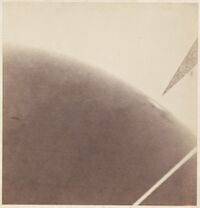
The beginning of Lithuanian photography is considered to be the daguerreotyping of the reconstructed Verkiai Palace, which was performed in the summer of 1839 by François Marcillac, the governor of the children of Duke Ludwig Wittgenstein, this fact is mentioned in the memoirs of architect Bolesław Podczaszyński published in January 1853 in the Gazeta Warszawska newspaper.[170] The unfavorable political situation in the country led to the slow development of new technology and cultural activities. The first known daguerreotype portrait atelier in Vilnius was opened in 1843 by C. Ziegler; such ateliers operated in Lithuania until 1859. One of the most famous photographers was K. Neupert, who came from Norway (since 1851 he worked in Vilnius and Druskininkai).[170]
In the 1860s with the spread of negative and positive collodion technology, glass negatives and albumen paper were used instead of daguerreotype plates, photo portraits of standardized formats became widespread and commercial photography ateliers were established in Vilnius and other Lithuanian cities. The first landscape and architectural photographs were created by Vilnius photographers Abdonas Korzonas and Albert Swieykowski, who compiled the first set of photographs in Lithuania – the Vilnius Album (32 images). In 1862, the Provisional Censorship Regulations were adopted, which determined the activities of photographic institutions; they were supervised by the Central Press Board of the Ministry of the Interior. Photographers ateliers (4 of 9) who participated in the January Uprising and photographed the rebels were closed, their images were annihilated and the authors were punished (e.g. A. Korzonas was deported to Siberia). Other prominent photographers of the 19th century were Stanisław Filibert Fleury (one of the pioneers of stereoscopic photography[171]), Aleksander Władysław Strauss, Józef Czechowicz.[170]
One of the most important facts about the use of photography for scientific purposes is the second photoheliograph in the world (the first was in London), which was installed in 1865 at the Vilnius University Astronomical Observatory, which was used to observe and photograph the sunspots.[170] Since 1868, for the first time in the world, a systematic photographic service of sunspots dynamics was launched in Vilnius.[172]
In 1927, Jan Bułhak in Vilnius established the first photography club in the present territory of Lithuania.[173]
In 1952, the editorial office of Švyturys magazine organized the first photography exhibition in Vilnius, the main object of which was photography itself (16 photographers participated).[170]
الحرف
Iron tools, weapons, brass, glass and silver jewelry have been produced in the present territory of Lithuania since the 1st century.[175] Later pottery and production of wood products became widespread, and weaving in the 2nd and 4th centuries. During the period of feudalism, home crafts were the most significant in the conditions of subsistence economy. In the 13th and 14th centuries, the separation of crafts from agriculture accelerated; crafts have become an independent branch of the economy. The Grand Dukes of Lithuania promoted the development of crafts in cities. Weaving, shoemaking, fur-making and other crafts predominated. With the introduction of foreign artisans (early 14th century), the development of crafts accelerated even further. The development of crafts and trade stimulated the growth of Vilnius and other Lithuanian cities. In the 14th and 15th centuries, crafts were already highly specialized (especially in the production of tools, household items, fabrics, clothing, weapons, and jewelry) and at the same time workshops were established, which trained and defended the interests of craftsmen. In the 16th century, the production of fine glassware began, goldsmithing was developed, and the level of pottery and weaving crafts rose. The Statutes of Lithuania (1529 and 1588 editions) mention 25 crafts.[175] Prominent European goldsmiths worked in the Vilnius Goldsmiths' Workshop (established in 1495), which controlled the trade of precious metals, gemstones and stood out for its wealth as it serviced the territory up to Daugava and Dnieper Rivers, as well as the Catholic Church in Lithuania, the manor of the Grand Duke, nobility, townspeople.[176] No less important was the Vilnius Mint, which was the main mint of the Grand Duchy of Lithuania and minted the Lithuanian denarius, shillings, groschens, thalers, ducats, and other coins from 1387 to 1666.[177]
In the second half of the 17th century, due to the economic turmoil caused by the Russo-Polish War, crafts declined, most of the goods were imported from abroad duty-free by Szlachta Lithuanian and Polish nobles and sold on their holdings. Crafts began to rise again in the second half of the 18th century to the first half of the 19th century and Vilnius was the largest Lithuanian craft center. After the abolition of serfdom, craft schools were established in the Lithuanian cities. The growing industry begun to push crafts from some areas of food processing, textiles and metalworking. However, crafts have long prevailed in clothing manufacturing, goldsmithing, wood, food processing, and other fields. During the years of Soviet occupation, craftsmen worked in artels (until 1960), after their abolition - in household service combines. After the restoration of Lithuania's independence, crafts complemented small and medium-sized businesses.[175]
اللغة
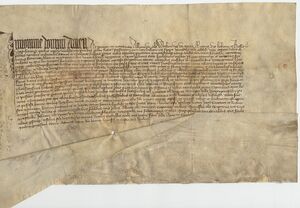
As a historically multicultural city, the language status changed significantly over the centuries. The predominant language of public life in medieval Lithuania was Lithuanian. It was spoken by commoners as well as in the ruler's manor and among the local nobility.[بحاجة لمصدر] However, the Lithuanian language had no literary traditions and was not used in writing, except for the most important religious texts (e.g. the Lord's and the Hail Mary prayers).[178][140] However, a spoken knowledge of Lithuanian was not lost, as Vytautas the Great spoke in Lithuanian with Jogaila, whose son Casimir IV Jagiellon also spoke Lithuanian.[179][180][181] Saint Casimir, the patron saint of Lithuania, was a polyglot and knew Lithuanian, Polish, German and Latin languages.[182] The Byzantine historian Laonikos Chalkokondyles in the 15th century reported that the Lithuanians had their own distinct language.[183][مطلوب مصدر أفضل]
The Ruthenian language was used in Lithuania and its capital Vilnius due to the incorporation of the Kievan Rus' lands. In colloquial form, these dialects formed the basis of the Ukrainian and Belarusian languages in the 19th century. The written form of the Ruthenian language stemmed from the interaction of Old East Slavic with the local elements of the Ruthenian language. Such a Ruthenian language became the main language of the Chancery of the Grand Duchy of Lithuania in the 14th and 15th centuries, and maintained its dominant position until the middle of the 17th century.[178][184]
Latin and Polish were also widely used in the Chancery of the Grand Duchy of Lithuania. In the second part of the 17th century, the Polish language ousted the Ruthenian language from the written sources and the Lithuanian language from most areas of the public life. The first state documents in the Lithuanian language appeared in the Grand Duchy of Lithuania only at the very end of its existence (e.g. Constitution of 3 May 1791 and the Great Sejm Lithuanian manuscripts, Kościuszko Uprising Lithuanian notes).[178]
At the royal court in Vilnius of Sigismund II Augustus, the last Grand Duke of Lithuania prior to the Union of Lublin, both Polish and Lithuanian were spoken equally widely.[186] In 1552, Grand Duke Sigismund II Augustus ordered that orders of the Magistrate of Vilnius be announced in Lithuanian, Polish, and Ruthenian languages.[187]
Minorities (e.g. Lithuanian Jews, Lipka Tatars, Crimean Karaites) were under the guardianship of the Grand Duke of Lithuania, but their languages were only used among themselves and never gained a significant role. The 2nd and 3rd Statutes of Lithuania consolidated Lithuanian Jews status as non-Christian and "common human" (non-noble).[188]
According to article 14 of the Constitution of Lithuania, Lithuanian is the only official language in the state. Therefore, all the official procedures in Vilnius are proceeded in Lithuanian. However, interpreter assistance is guaranteed by the state in some cases.[189]
Fashion
It is known that the Vilnians have enjoyed to expensively dress up since the Middle Ages. According to historian Antanas Čaplinskas, even the merchants and craftsmen wives were wearing multiple rings decorated with gemstones (e.g. with ruby and fourteen diamonds). Those who did not dress up and did not followed the fashion trends were even ridiculed (e.g. for wearing sheepskins, for not wearing luxurious belts, gloves, or for not using handkerchiefs). Property inventories of 16th–17th centuries often mention expensive clothing, such as long, wide-sleeved jackets of precious materials, known as kontusz, and żupans decorated with lynx's or other animal fur, also kontush belts.[190] Special attention was paid to the buttons as in the list of one nobleman's property Čaplinskas found 12 buttons with pearls and corals, about 100 large buttons with diamonds, plum-shaped buttons decorated with enamel, as well as buttons made from brilliants, emeralds.[190] Delias and dolmans were also popular among the townspeople and nobles.[191]
Wealthy townspeople, decorated with luxurious clothing, raised the envy of the Lithuanian nobility and the nobles demanded the adoption of laws limiting the clothing of the townspeople. For the first time such restrictions were recorded in the Statute of Lithuania of 1588, according to which the townspeople were allowed to wear only two rings (one of them was the seal) while Jews were forbidden to adorn with gold chains and brooches (though, the Jewish women had more rights).[190] Even wider restrictions were put in place by the Sejm of the Polish–Lithuanian Commonwealth which adopted the Act of Thrift in 1613, according to which the non-noble townspeople were forbidden to appear in public places dressed in expensive furs (violators of the law were fined and the clothes were given to the complainants).[190] The wealthy townspeople were not satisfied with such limitations, therefore a subscription fee was introduced later which removed all limitations.[190]
The clothing trends changed in the late 18th century when almost all men already had shaved beards, short-haired hairstyles and began to wear trendy, blue, green or black tailcoats with open-fronts and waistcoats matched with white or yellowish trousers,[191] while the 18th century women's clothing fashion had almost no differences from the Western European fashion trends. In the early 20th century the clothes were already in line with the Western European fashion trends, and in 1961 clothing designers studies were launched in the State Art Institute of Lithuania, also in the same year the Vilnius Model House was established which created and popularized unique and industrial apparel and footwear models, made clothing presentations.[192]
Mados infekcija (إنگليزية: Fashion Infection) was launched in 1999 and is the biggest Lithuanian fashion show, held every spring in Vilnius.[193] Prominent Lithuanian clothing designer Juozas Statkevičius usually organizes his collections presentations in Vilnius.[194]
العطلات والأعياد
As a result of centuries long Catholic traditions in Vilnius and Lithuania, the Catholic holidays (e.g. Christmas, Easter, Saint John's Eve) are widely celebrated and employees have a days off.[195]
Every year on 16 February (day of the Act of Independence of Lithuania) and on 11 March (day of the Act of the Re-Establishment of the State of Lithuania) festive events are organized in Vilnius with official ceremonies conducted by the heads of state and the holy masses of the Lithuanian Catholic Church in the Vilnius Cathedral.[196][197] While in the evening of 12 January bonfires are ignited to mark the bloody January Events.[198]
Saint Casimir's Fair (لتوانية: Kaziuko mugė) has been held annually for hundreds of years in the city's markets and streets on the Sunday nearest to 4 March (Feast of St. Casimir), the anniversary of Saint Casimir's death. It attracts tens of thousands of visitors and many Lithuanian and foreign craftsmen. Easter palms (لتوانية: Verbos) are one of the most recognizable symbols of the fair.[199]
Capital's Days (لتوانية: Sostinės dienos) is the biggest festival of music and culture held in the city annually for three days (from 30 August to 1 September).[200]
Although it is not a national holiday, the Vilnia River is dyed green every year for Saint Patrick's Day.[201]
During the annual Vilnius Culture Night various artists and cultural organisations hold events and performances all over the city.[202]
الإدارة
حكومة المدينة

Before the Magdeburg rights were granted to Vilnius in 1378, the city was overseen by the ruler's vicegerents. Later these duties were granted to a magistrate or a City Council, subordinate only to the ruler himself. During wars, when the city was in a danger, the city was led by a Voivode of Vilnius.[203] The magisterial authority was headquartered at the Vilnius Town Hall.[204]
Vilnius Magistrate was responsible for the city economy, was collecting taxes, taking care of the city treasury, was accumulating stocks of grain in order to avoid residents starvation in case of famine or wars. He also acted as a notary in transactions, testaments and as a judge during the city residents conflicts that involved new buildings constructions and reconstructions. His other function was taking care of the city craftsmen. From the beginning, statutes of workshops were approved by the ruler himself. Later, Sigismund II Augustus granted this privilege to the city magistrates in 1552. Since the 1522 privilege by Sigismund I the Old, Vilnius Magistrates had the responsibility to protect the city and its resident's tranquility by having 24 armed guards. During war times, the night watch was performed by three jurisdictions – magistrate, bishop and castle men.[203][205]
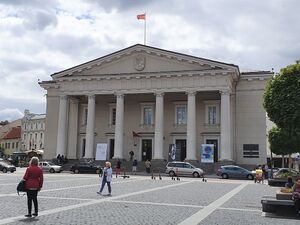
Chief City Administrator was vaitas (a Grand Duke of Lithuania vicegerent in the city).[206] Most of them were beginning their careers in the magistracy before obtaining such a position. All vaitai were Catholics. Vaitas was chairing during the City Council meetings. His competence also included criminal cases and he had the right to impose a death penalty. At first, he examined the cases alone, however since the 16th century two suolininkai also examined important cases (if the lawsuit was over 10 groschen) together with the vaitas. In the 16th century, Vilnius City Council consisted of 12 burgomasters and 24 councilors (half of them were Catholics, the other half were orthodoxes). There were no direct elections to the City Council and members to the council were chosen by the wealthy townspeople, merchants, workshops seniors. Burgomasters were being chosen until their deaths. In case of death, another member of the council was being chosen of the same religion. In 1536, Sigismund I the Old signed a privilege which regulated the magistracy formation principles that prohibited to choose close relatives to the council and all the new taxes, obligations and regulations required the prior agreement of the townspeople.[203]
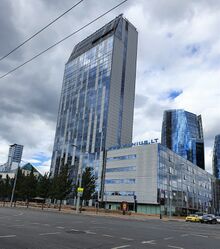
Under the Russian Empire, the City Council was replaced with a City Duma.[207] The city was the capital of the Lithuania Governorate in 1797–1801, Vilna Governorate-General in 1794–1912, and Vilna Governorate in 1795–1915.[208][209]
After the Soviet occupation of Lithuania, Vilnius became a republican subordinate city and capital of the Lithuanian Soviet Socialist Republic.[207]
The current Vilnius City Municipal Council was established in 1990.[207] The Vilnius City Municipality is one of 60 municipalities of Lithuania and includes the nearby town of Grigiškės, three villages, and some rural areas.[210] The town of Grigiškės was separated from the Trakai District Municipality and attached to the Vilnius City Municipality in 2000.
A 50-member council is elected to four-year terms; the candidates are nominated by registered political parties and committees.[211] As of the 2011 elections, independent candidates also were permitted.[212] The last election was held in March 2019 and the results were: Public Election Committee "R. Šimašius Team "For Vilnius, which we are proud of" (17 seats), A. Zuokas and Vilnius Citizens Coalition "Happy Vilnius" (10 seats), Homeland Union – Lithuanian Christian Democrats (9 seats), the coalition of the Electoral Action of Poles in Lithuania and Russians Alliance "Christian Families Alliance" (6 seats), Labour Party (5 seats), Lithuanian Farmers and Greens Union (3 seats).[211][213]
Before 2015, mayors were appointed by the council.[214] Starting with the elections in 2015, the mayors are elected directly in a two-round system by voters registered in the municipality.[214] Remigijus Šimašius became the first directly elected mayor of the city.[215]
التقسيمات
Elderships, a statewide administrative division, function as municipal districts. The 21 elderships are based on neighbourhoods:
- Verkiai – includes Baltupiai, Jeruzalė, Santariškės, Balsiai, Visoriai
- Antakalnis – includes Valakampiai, Turniškės, Dvarčionys
- Pašilaičiai – includes Tarandė
- Fabijoniškės – includes Bajorai
- Pilaitė
- Justiniškės
- Viršuliškės
- Šeškinė
- Šnipiškės
- Žirmūnai – includes Šiaurės miestelis
- Karoliniškės
- Žvėrynas
- Grigiškės – a separate town
- Lazdynai
- Vilkpėdė – includes Vingis Park
- Naujamiestis – includes bus and train stations
- Senamiestis (Old Town) – includes Užupis
- Naujoji Vilnia – includes Pavilnys, Pūčkoriai
- Paneriai – includes Trakų Vokė, Gariūnai
- Naujininkai – includes Kirtimai, Salininkai, Vilnius International Airport
- Rasos – includes Belmontas, Markučiai[210]
| Eldership | Area (km2) | Population[216] | Density (per km2) |
|---|---|---|---|
| Antakalnis | 77.2 | 39,257 | 510 |
| Fabijoniškės | 4.1 | 37,006 | 9,000 |
| Grigiškės | 7.1 | 10,335 | 1,500 |
| Justiniškės | 3.0 | 25,956 | 8,700 |
| Karoliniškės | 4.0 | 24,751 | 6,200 |
| Lazdynai | 9.9 | 30,945 | 3,100 |
| Naujamiestis | 4.9 | 28,157 | 5,700 |
| Naujininkai | 41.1 | 30,030 | 730 |
| Naujoji Vilnia | 39.3 | 36,800 | 940 |
| Paneriai | 84.8 | 11,149 | 130 |
| Pašilaičiai | 7.9 | 40,384 | 5,100 |
| Pilaitė | 13.9 | 28,234 | 2,000 |
| Rasos | 16.3 | 10,230 | 630 |
| Senamiestis (Old Town) | 4.5 | 21,782 | 4,800 |
| Šeškinė | 4.4 | 28,137 | 6,400 |
| Šnipiškės | 3.1 | 16,474 | 5,300 |
| Verkiai | 55.7 | 50,754 | 910 |
| Vilkpėdė | 10.8 | 19,325 | 1,800 |
| Viršuliškės | 2.5 | 13,877 | 5,600 |
| Žirmūnai | 5.7 | 43,453 | 8,600 |
| Žvėrynas | 2.6 | 12,089 | 4,700 |
بلدية المقاطعة
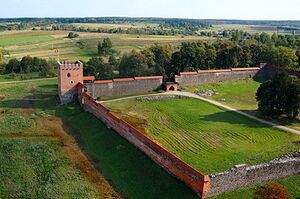
Vilnius District Municipality (لتوانية: Vilniaus rajono savivaldybė) is one of the largest municipalities in Lithuania. It occupies 2129 square kilometres and has 23 civil parishes. There are 1163 villages and 5 towns (Nemenčinė, Bezdonys, Maišiagala, Mickūnai and Šumskas) in the district. Vilnius district surrounds the Lithuania's capital and has developed public, business rural infrastructure and offers high standard of living with clean environment. Vilnius district borders with the Republic of Belarus and neighbours with Švenčionys, Moletai, Širvintos, Elektrėnai, Trakai and Šalčininkai districts.[218]
Vilnius district has a multinational population, of which 52% are Poles, 33% are Lithuanians and the rest of 16% are Russians, Belarusians and other nationalities residents (e.g. Ukrainians, Lipka Tatars, Jews). Vilnius district has over 100,000 residents. Most of the population (95%) live in villages and 5% live in towns.[218]
Vilnius district has the highest terrains of Lithuania – Aukštojas, Juozapinė and Kruopinė Hills, which are raised over 290 metres above sea level and are considered very high in the country's flatlands.[218]
Palm Sunday is widely celebrated in the district and the unique and colorful Vilnian Easter palms (verbos) are made there from dried flowers and herbs.[219] The tradition of making Vilnius palms is dated to the times of St. Casimir, who is a patron saint of Lithuania and Lithuanian youth.[218]
Medininkai Castle, Liubavas Manor mill and Bareikiškės Manor are the most famous historical landmarks of the district.[218]
Vilnius Voivodeship from 1769 surrounded a completely independent microstate Republic of Paulava, known for its Age of Enlightenment values, with its own president, peasants parliament, army and laws.[220]
As a result of its large Polish population, Vilnius District Municipality Council mostly consists from members of the Electoral Action of Poles in Lithuania.[221] Its mayor is Robert Duchnevič from the Lithuanian Social Democratic Union.[222]
الحكومة الوطنية
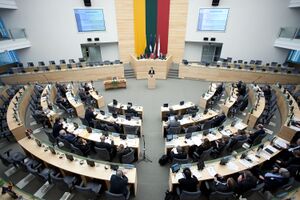
As the capital of Lithuania, Vilnius is the seat of Lithuania's national government. For the executive, the two chief officers of Lithuania have their offices in Vilnius. The President of the Republic of Lithuania resides at the Presidential Palace in Daukanto Square,[223] while the Prime Minister's seat is at the Government of Lithuania office in Gediminas Avenue.[224] According to the Law of the President of the Republic of Lithuania, the President of the Republic has a residence in Vilnius that is located in Turniškės district near Neris river.[225][226] Prime Minister also has a right to a residence in Turniškės district during term in office.[227] Government ministries are located in various parts of the city; many are located in Vilnius Old Town.[228]
Historically, the Seimas of the Grand Duchy of Lithuania mostly gathered in Vilnius.[229] The present-day Seimas of the Republic of Lithuania is also located in Vilnius and meets at the Seimas Palace in Gediminas Avenue.[230]
Lithuania's highest courts are located in Vilnius. The Supreme Court of Lithuania (لتوانية: Lietuvos Aukščiausiasis Teismas), the highest court in the judicial order, which reviews criminal and civil cases, is located in the Gynėjų Street,[231] while the Supreme Administrative Court of Lithuania (لتوانية: Lietuvos vyriausiasis administracinis teismas), which acts as the highest court in the administrative order, judging litigation against public bodies, is located in the Žygimantų Street.[232] The Constitutional Court of Lithuania (لتوانية: Lietuvos Respublikos Konstitucinis Teismas), an advisory body with ultimate authority on the constitutionality of laws meets in the Constitutional Court's Palace in Gediminas Avenue.[233]
The Lithuanian Tribunal, the highest appeal court for the nobility of the Grand Duchy of Lithuania, was established by Stephen Báthory, Grand Duke of Lithuania and King of Poland, in 1581. It was located in Vilnius until the Third Partition of Poland in 1795.[234]
خدمات خاصة
The security of Vilnius is mainly the responsibility of the Vilniaus apskrities vyriausiasis policijos komisariatas, the highest police office in the city, and local police offices. Its main responsibilities are ensuring public order and public safety, disclosure and investigation of criminal offenses and traffic safety supervision.[235] In 2016, there were 1500 police officers in Vilnius.[236] Public Security Service is responsible for the prompt restoration of public order in extreme and special situations and ensure proper protection of important state objects and escorted subjects.[237]
Vilniaus apskrities priešgaisrinė gelbėjimo valdyba is the primary governing body of the Vilnius's firefighters forces.[238] In the first 9 months of 2018, there were 1287 fire incidents in the city of Vilnius, during which 6 people died and 16 were traumatized.[239]
Vilniaus greitosios medicinos pagalbos stotis is responsible for emergency medical services in the city and can be contacted directly by calling a short number 033.[240] It is one of the oldest emergency medical services institution in eastern Europe and was established already in 1902.[241] Large part of this institution doctors and other personnel were awarded with medals for their assistance to victims during the January Events in 1991.[241]
Major number for contacting all the special services in Vilnius (and other regions of Lithuania) is 112.[242]
Cityscape
Urbanism and architecture
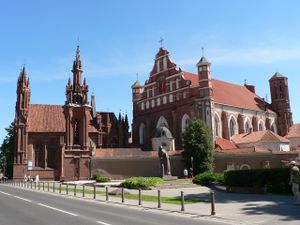
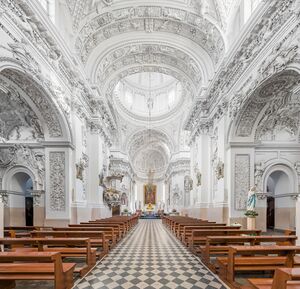
The Old Town of Vilnius is the historical centre of Vilnius, about 3.6 km2 (1.4 sq mi) in size. Its history begins from the Neolithic period. During it, the glacial hills were intermittently occupied and a wooden castle, at the confluence of the Neris and Vilnia rivers, was built around 1000 AD to fortify Gedimino Hill. The settlement developed into a town in the 13th century, when the pagan Baltic people were invaded by the Westerners during the Lithuanian Crusade. Around 1323, when the first written sources about Vilnia occurred, it was the capital of the Grand Duchy of Lithuania, which was formed from various cultures and nationalities residents. At this time, it only had some brick structures. By the 15th century, the Grand Duchy of Lithuania had become one of the most powerful and the largest country in Europe with its territory stretching from the Baltic Sea to the Black Sea (mostly, present-day Belarus, Ukraine and Russia lands). The historic centre consists of three castles territories (Upper, Lower and Curved) and the area that was previously encircled by a Wall of Vilnius. Its plan is mostly circular with its center in the original castle site. The streets pattern is medieval and has small, narrow streets, however large squares were also developed in later periods.[243] Pilies Street, the main artery, links the Palace of the Grand Dukes of Lithuania with Vilnius Town Hall. Other streets meander through the palaces of feudal lords and landlords, churches, shops and craftsmen's workrooms.
The historic buildings are in Gothic (e.g. Church of St. Anne),[248] Renaissance (e.g. Palace of the Grand Dukes of Lithuania),[249] Baroque (e.g. Church of St. Peter and St. Paul with over 2,000 stucco figures interior, Vilnius University's main campus, which features 13 courtyards framed by 15th century buildings and splashed with 300-year-old frescoes, and the Church of St. Johns)[250] and Classical styles (e.g. Vilnius Cathedral, Vilnius Town Hall, Šuazeliai Palace, Verkiai Palace)[251] with splendid exteriors and interiors. The variety of preserved churches and former palaces of the Lithuanian nobility especially constitutes the Vilnius multicultural heritage.[243][252]
As a capital of the massive state, Lithuanians shaped the development of its outstanding capital together with other nations. Vilnius development was influenced by the West and East ideologies. Christianity has dominated in Lithuania since the Christianization of Lithuania in 1387, however Orthodoxy of the state's eastern residents and the growing importance of Judaism led to exemplary material manifestations of these religious communities (e.g. Orthodox Cathedral of the Theotokos, Great Synagogue of Vilna).[243]
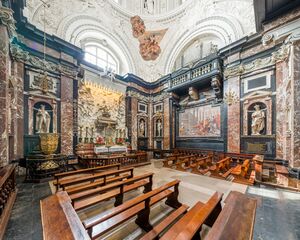
Various disasters resulted in reconstructions of the Vilnius buildings in the School of Vilnius Baroque style, which later left an imprint in the whole Grand Duchy of Lithuania.[243][253] Talented artists (e.g. Matteo Castelli, Pietro Perti) from the present-day Canton of Ticino were particularly preferred by the Grand Duke of Lithuania and local nobility, and developed many famous objects in the city (e.g. Chapel of Saint Casimir).[254] Lithuanian Laurynas Gucevičius left a huge mark in the Classical style architecture of Vilnius.[255]
Vilnius Old Town was inscribed to the list of the UNESCO World Heritage Sites in 1994. The inscribed property has an extension of 352 ha. Vilnius Historic Centre is particularly noted for maintaining the medieval streets pattern without any significant gaps. However, some places were damaged during Lithuania's occupations and wars, including the Cathedral Square that covers the foundations of the Royal Palace – demolished after the 3rd partition of the Polish–Lithuanian Commonwealth in 1795, a square in the east from the Church of All Saints where the Convent of the Barefoot Carmelites previously stood alongside a Vice-Chancellor Stefan Pac's established Baroque Church of St. Joseph the Betrothed, both demolished by the tsar's order. Great Synagogue and part of the buildings in the Vokiečių Street (ألمانية: Deutsche Gasse) were demolished after World War II.[243]
Vilnius occupies an area of 401 square kilometers, of which only one fifth is developed and the remainder is green belt and water. For this reason, Vilnius is often referred to as one of the 'greenest' capital cities in Europe.[256]
Crypts
The crypts of Vilnius Cathedral are a place where prominent figures of Lithuania and the Catholic Church are buried. At the Royal Mausoleum Grand Duke Alexander Jagiellon, Queen Elizabeth of Austria, Barbara Radziwiłł, heart of the Grand Duke Władysław IV Vasa are buried. These crypts also have one of the oldest frescos in Lithuania, painted in the late 14th or early 15th century, and dating to the times of the Christianization of Lithuania.[257]
Housing
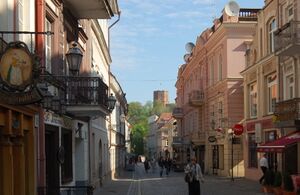
Vilnius Old Town (لتوانية: Vilniaus senamiestis) with medieval stone paved streets and Užupis offers one of the most prestigious housing in Vilnius. Many old town apartment buildings there offers direct views to the iconic churches or the biggest landmarks of the city (e.g. especially desired Gediminas Tower), enclosed inner courtyards, high ceilings, attics, non-standard layouts and luxurious historic interiors.[258] Most expensive flats in these neighbourhoods may cost millions of euros and are accessible only to the wealthiest residents of the city.[259] However, such problems as traffic jams, expensive car parking spaces, air pollution, high costs of maintenance, limitations for reconstructions repels rich Vilnians from living in these neighbourhoods, who often buy or build private houses in more distant parts of Vilnius (Balsiai, Bajorai, Pavilnys, Kalnėnai, Pilaitė and others) or nearby areas of the Vilnius District Municipality.[258] Around 21,000 residents live in the old town and 7,000 in Užupis.[260]
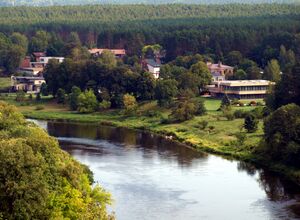
Valakampiai and Turniškės are the city's most prestigious places with private houses quarters as plots there are sufficiently large, surrounded with the greenery, pines forests and are easily accessible from the city centre. Generally, exceptionally wealthy residents and heads of the state (e.g. presidents) live there and most of the larger private houses costs millions of euros.[258][261] Part of the Žvėrynas neighbourhood also offers luxurious private houses with plots close to the Vingis Park, but it also has the Soviet-era apartment buildings, poor condition wooden houses, higher number of residents (~12,200[260]).[258]
Neighbourhoods around the old town (Antakalnis, Žirmūnai, Naujamiestis, Žvėrynas) offer a wide variety prices flats, decent amount of greenery suitable for walks, bicycle roads and therefore are the most popular among the middle class residents. Wealthier communities are living in a new construction apartments or renovated Soviet-era apartments.[258] The Government of Lithuania strongly supports the renovation process and compensates 30% or more of the cost.[262] However, poorer inhabitants and low income pensioners are often stopping the process adding to overall regionalistic policies of the politicians.[263][264]
More distant neighbourhoods (e.g. Lazdynai, Karoliniškės, Viršuliškės, Šeškinė, Justiniškės, Pašilaičiai, Fabijoniškės, Naujininkai) are offering significantly cheaper flats. Their biggest disadvantages together with a more difficult communication with the city centre are mostly not renovated Soviet-era high-rise buildings, worn out surroundings, large traffic jams on the streets connecting with the city centre during the rush hours and a constant lack of car parking spaces near older apartments.[258][265]
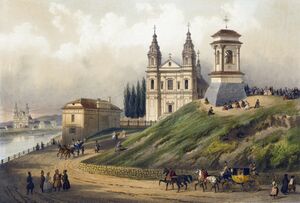
Šnipiškės eldership has received a significant amount of investment during the 2010s. The area was first mentioned in the Vilnius's historical documents in 1536 when the Grand Duke Sigismund I the Old ordered Ulrich Hosius to build a wooden bridge over the Neris river. Soon around the bridge, a suburb began to develop. In the 16th a palace dedicated to the Muscovites and Tatars messengers was built by the magistrate of Vilnius to the north of Šnipiškės, as during their visits, they acted noisily and the townspeople did not want them around.[266] In the 18th century, a Jesuit's Church of St. Raphael the Archangel and monastery as well as solid palaces of the rich and multi-story brick houses of ordinary townspeople were built in Šnipiškės. On the other hand, the outskirts of this suburb were inhabited by the craftsmen: the glass-makers, brick-makers, pottery-makers. Smoking pipe factory, sawmills and even a tiny candy factory emerged. A small part of the territory (8 ha) of Šnipiškės west of the Kalvarijų market, called Skansenas,[267] occupied mostly by poor condition wooden houses, emerged in the late 19th century. Surprisingly, it survived to this day and is now still underdeveloped territory, protected by the state. Next to it, then-luxurious quarter of bankers – Piromontas[268] was built in the 1890s, is architectural heritage too.
During the 1960s, the Šnipiškės area was named the New City Centre: the first city pedestrian zone organized and before the 1990 a number of buildings, including the largest shopping centre in what was then Lithuanian SSR, the highest and the largest hotel, planetarium, museum of Revolution, Pioneer's Palace as well as number of ministries of the Lithuanian SSR were built.[269][270][271][272][273] However, the broader territory of Šnipiškės, stretching to the north of what is now Konstitucijos Avenue, remained mainly underdeveloped until the early 2000s when the new Vilnius city municipality building was built in the area, that inspired transformation of the surroundings: the new Europa square formed with a new shopping center "Europa", 33-story "Europa" business tower and 27-story "Europa" apartment building. Former Museum of Revolution was reconstructed into the National Art Gallery in the late 2000s. Since then skyscrapers and expensive commercial offices are being built constantly in the area. It already has almost 0.5 million square meters of real estate.[274]
In 2019, average price for 1 m2 (11 sq ft) of flat was around 2,000 euros and around 1,200 euros for 1 m2 (11 sq ft) of a private house in Vilnius, while the rent prices were ~€10 /m2 (for flats) and ~€8 /m2 (for private houses) respectively.[275] According to the economists, number of transactions and housing affordability index has reached record highs in 2019 because of the significant rise in Vilnius residents incomes and slowing of the flats prices rising.[276] Despite that, according to a research one fourth of the 26–35 years old inhabitants are still living in their parents or relatives owned homes, which is the highest number in the Baltic states, however it is likely that large part of these young people are simply saving for their own homes or the initial contribution because statistics traditionally shows that Lithuanians purchases their homes with less borrowed funds than Latvians or Estonians.[277]
السكان
| Year | Population |
|---|---|
| 1530 | 30,000 |
| 1654 | |
| 1766 | ▲ 60,000 |
| 1795 | |
| 1800 | ▲ 31,000 |
| 1811 | ▲ 56,300 |
| 1818 | |
| 1834 | ▲ 52,300 |
| 1861 | ▲ 60,500 |
| 1869 | ▲ 64,400 |
| 1880 | ▲ 89,600 |
| 1886 | ▲ 103,000 |
| 1897 | ▲ 154,500 |
| 1900 | ▲ 162,600 |
| 1911 | ▲ 238,600 |
| 1914 |
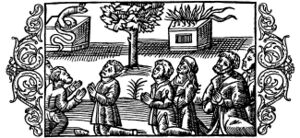
Vilnius has thousands of years of demographics history as in the eldership of Vilkpėdė the remains of the Magdalenian culture settlement were found, which are dated to around 10,000 years BC. In the first 1,000 years AD there were large settlements in Kairėnai, Pūčkoriai and Naujoji Vilnia.[24] The most densely populated area was the confluence of the Neris and Vilnia Rivers, which also had fortified homesteads.[24] Later Vilnius was part of the Kingdom of Lithuania territory, however King Mindaugas did not constantly reside in it, despite building the first Catholic Church in Lithuania there on the occasion of his coronation.[281][24] The city began to develop in the late 13th century, during the reign of Grand Dukes Butvydas and Vytenis.[23]
Major growth of Vilnius as the centre and capital of the medieval state is attributed to the 14th century reign of Grand Duke Gediminas who invited knights, merchants, doctors, craftspeople and others to come to the Grand Duchy to practice their trades and faith without restriction.[24] Although, the growth of Vilnius was limited at the time due to the brutal Teutonic Order attacks (e.g. during their assault in 1390 around 14,000 Vilnians were killed) and the Lithuanian Civil War of 1389–1392.[24]
Vilnius developed as a multicultural city. In the 14th century sources it is mentioned that Vilnius consists of the Great (Lithuanian) city and Ruthenians city. Until the 16th century the city was mostly inhabited by Lithuanians and Ruthenians, however the German merchants, artisans, Jews (since the 14th century; later had their qahal until 1845) and the Tartars (since 1397) also settled down in Vilnius. In the 16th–17th centuries, during Reformation and Counter-Reformation, the Polonophone population began to grow – by the middle of the 17th century most writings were in Polish due to the Polonisation (before the 16th century the number was only around 5%).[24]
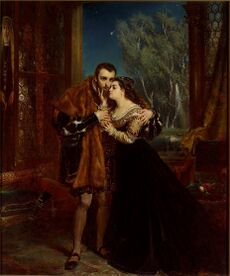
The city prospered during the Golden Age by being one of the main cities of the Polish–Lithuanian Commonwealth and the residence of the Lithuanian nobility.[283][284] However, the city was severely devastated by fire in 1610. After the Battle of Vilnius in 1655 the city came under Russian control (1655–1661). Next, after the Great Northern War, the Swedish Empire controlled the city from 1702 to 1709. This occupation ended during the Great Northern War plague outbreak in 1709. It took the city more than 50 years to recover.[24]
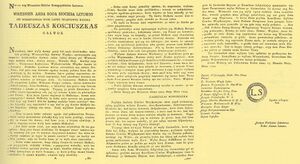
According to the first population census of the Commonwealth in 1790, the Vilnius Voivodeship (without the Grodno County) had a population of 718,571 residents, while the Vilnius County had 105,896 residents (the whole Grand Duchy after the Second Partition had a population of 1,333,493 then).[285] Shortly after, the city population decreased to just 17,500 residents in 1796 due to the fierce battles of the Vilnius uprising in 1794, which was the last attempt to save the Grand Duchy's capital from falling under the complete Russian control.[24][36] Though, after the rebels defeat, Vilnius was incorporated into the Russian Empire and was its third largest city in the beginning of the 19th century.[24] After a few decades of the Russian despotism, Vilnius demographics were once again affected by the November Uprising in 1830 and the January Uprising in 1863, during which rebels attempts were made to restore the statehood.[24] According to the Russian Empire Census of 1897, Vilnius had 154,532 residents and later grown to 205,300 residents in 1909, while the Vilna Governorate had 1,561,713 residents in 1897.[286][287]
During World War I thousands of Vilnians were forced to flee, were killed or were taken to the forced labor camps; consequently the city had only 128,500 residents in 1919 (in total, the present-day Lithuania territory lost around 1 million residents).[24][288] Vilnius recovered during the interwar period and had 209,442 residents in 1939,[289] but due to World War II the number fell to 110,000 in 1944.[24]
Vilnius again grew in population by being the capital of the Lithuanian Soviet Socialist Republic (according to the 1989 census, it had 576,747 residents).[24] Despite the fact that almost whole Lithuania suffered from a large emigration after the restoration of independence in 1990, the number of residents in Vilnius remained almost unchanged (542,287 in 2001) and began to steadily grow every year since 2006 to 580,020 residents (as of 1 January 2020).[24][290]
التركيبة العرقية التاريخية
| السنة | اللتوان | الپولنديون | الروس | اليهود | غيرهم | الإجمالي | |||||
|---|---|---|---|---|---|---|---|---|---|---|---|
| 1897[291] | 3,131 | 2% | 47,795 | 31% | 30,967 | 20% | 61,847 | 40% | 10,792 | 7% | 154,532 |
| 1916[292] | ▲ 3,669 | 2.6% | ▲ 70,629 | 50.1% | 1.5% | 43.5% | 2.3% | ||||
| 1917[293] | 2.1% | ▲ 74,466 | 53.65% | ▲ 2,212 | 1.6% | 41.44% | 0.77% | ||||
| 1919[292] | 2.3% | 56.1% | ▲ 4,049 | 3.2% | 36.2% | ▲ 2,954 | 2.3% | ||||
| 1923[292] | 0.9% | ▲ 100,830 | 60.2% | ▲ 4,669 | 2.8% | ▲ 56,168 | 33.5% | ▲ 4,342 | 2.6% | ▲ 167,454 | |
| 1931[294] | ▲ 1,579 | 0.8% | ▲ 128,628 | 65.9% | ▲ 7,372 | 3.8% | 28% | 0.6% | ▲ 195,071 | ||
| 1941[295] | ▲ 52,370 | 28.1% | 50.7% | 3.6% | 16.2% | ▲ 2,541 | 1.4% | ||||
| 1942[292] | 20.5% | ▲ 103,203 | 71.9% | 2% | — | — | 0.4% | ||||
| 1951[292] | ▲ 55,300 | 30.8% | 21% | ▲ 59,700 | 33.3% | 3.1% | ▲ 21,100 | 11.8% | ▲ 179,300 | ||
| 1959[296] | ▲ 79,363 | 33.6% | ▲ 47,226 | 20% | ▲ 69,416 | 29.4% | ▲ 16,354 | 6.9% | ▲ 23,719 | 10% | ▲ 236,078 |
| 1970[292] | ▲ 159,156 | 42.8% | ▲ 68,261 | 18.6% | ▲ 91,004 | 24.5% | ▲ 16,491 | 4.4% | ▲ 37,188 | 10% | ▲ 372,100 |
| 1979[292] | ▲ 225,137 | 47.3% | ▲ 85,562 | 18% | ▲ 105,618 | 22.2% | 2.3% | ▲ 48,785 | 10.3% | ▲ 475,825 | |
| 1989[292] | ▲ 291,527 | 50.5% | ▲ 108,239 | 18.8% | ▲ 116,618 | 20.2% | 1.6% | ▲ 51,524 | 8.9% | ▲ 576,747 | |
| 2001[297] | ▲ 318,510 | 57.5% | 18.9% | 14.1% | 0.5% | 9.1% | |||||
| 2011[298] | ▲ 337,000 | 63.2% | 16.5% | 12% | 0.4% | 8.6% | |||||
| 2021[299] | ▲ 373,511 | 67.1% | 15.4% | 9.7% | — | — | 7.8% | ▲ 556,490 | |||
Around 1000 years AD, the confluence of the Neris and Vilnia rivers was densely populated by the Brushed Pottery culture, which had a half a hectare fortified settlement on the Gediminas' Hill.[300] The tribes of this culture were common throughout present-day Lithuania, east of the Šventoji River and in western Belarus. The direct descendants of this culture were a Baltic tribe – the Aukštaitians (إنگليزية: Highlanders).[300] According to a prominent researcher of Vilnius history Antanas Čaplinskas, who researched the surnames of Vilnius residents in the archive documents of the city, the oldest surviving surnames of Vilnius residents are Lithuanian.[300] Pagan Lithuanians mostly lived at the northern foot of Gediminas' Hill and in the Crooked Castle.[301]
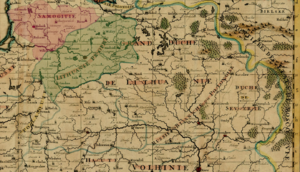
Later, following the invitation of Grand Duke Gediminas, merchants and craftsmen began to move to Vilnius from the cities of the German Hanseatic League, France, Italy and Spain, and replaced the Lithuanian surnames with German, Polish, and Russian surnames.[300] In the late 14th century, during the reign of Grand Duke Algirdas, Vilnius already had a Ruthenian quarter (لاتينية: Civitas Ruthenica) in the present-day Latako and Rusų Streets, as the trade relations between the Grand Duchy of Lithuania and the Ruthenian principalities were quite well developed, therefore quite a few Ruthenian merchants lived there and the Ruthenian nobles had their residences in the quarter.[300][301][302] The variety of nations in Vilnius was further increased by Grand Duke Vytautas the Great, who introduced Litvak Jews, Tatars and Crimean Karaites.[303] After a few hundred years, the number of locals in Vilnius was smaller than the number of newcomers.[300] However, according to an analysis of the tax registers of 1572, Lithuania proper had 850,000 residents of which 680,000 were Lithuanians.[285]
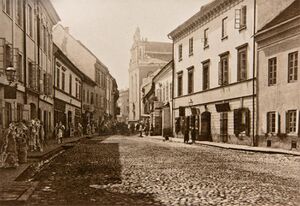
Beginning during the Polish–Lithuanian Commonwealth, the Polish culture began to penetrate the city rapidly and soon the Polish language prevailed in the city, even the Magistrate's documents were written in Polish until the November Uprising in 1831.[300] After living for a while in Vilnius, foreign merchants and artisans quickly assimilated and were Polonized.[300] The majority of the Lithuanian nobles spoke the Polish language, however they never considered themselves Poles and the Union of Lublin was only signed during the second attempt in 1569, with the agreement that both states will be sovereign entities within the Commonwealth.[304] Their opinion did not change within the union and was confirmed again in the Reciprocal Guarantee of Two Nations in 1791.[305]
Over the centuries, the composition of the population of Vilnius changed to become ethnically less Lithuanian.[300] According to historian Vytautas Merkys, the city lost a great deal of its old population during the brutal rampages of the Swedish and Russian armies in the 17th and 18th centuries, and they were replaced by the newcomers, however the Lithuanians also constantly inhabited in Vilnius.[300] According to the Russian Empire Census of 1897, only 2.1% (3200 residents) identified themselves as Lithuanian-speakers, while the speakers of Polish language (30.8%; 47,600 residents) and Yiddish (40.0%; 61,800 residents) were the largest linguistic groups of the city.[306] According to the Parish censuses of 1857–1858, the Lithuanian population remained significant in the Vilna Governorate and, according to different authors, was between 23.6% and 50.0% (210,273–418,880 residents).[286] In 1863, ethnographer Roderich von Erckert identified that the largest ethnic group in the Vilna Governorate were Lithuanians (45.04%; 386,000 residents).[307] Among the Szlachta (nobility) in Vilnius during the census of 1897, there were 5,301 (46.3%) local nobles and 6,403 (54.7%) newcomers, of these 24.1% noble newcomers came from Vilna Governorate territories, while the rest of newcomers nobles came to Vilnius from Grodno Governorate, Minsk Governorate, Vitebsk Governorate, Kovno Governorate, Vistula Land and other regions.[308]
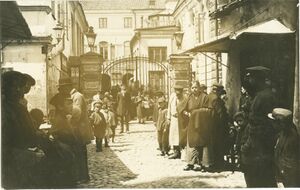
Ethnic Lithuanian numbers in the city of Vilnius reached record lows in 1931 (1600 residents – 0.8%, while Poles accounted for 65.9% – 128,600 residents) following the 1922 annexation of Vilnius Region by Poland and the Lithuanians retreat from the region to the temporary capital of Kaunas.[309]
Following the Soviet–Lithuanian Mutual Assistance Treaty in 1939, Lithuania regained one third of Vilnius Region and made efforts to Lithuanize Vilnius by the introduction of Lithuanian laws.[310] Prime Minister Antanas Merkys once said that it was intended "to make everybody think like Lithuanians. First of all, it was and still is necessary to comb out the foreign element from the Vilnius Region".[310] The Lithuanian Government put into force a law according to which "who on 12 July 1920 (...) were regarded as Lithuanian nationals, and on 27 October 1939 were resident in the territory became Lithuanian nationals" (this definition of citizenship was used to dismiss a large number of Polish civil servants as during the Interbellum period about 88,000 Poles migrated to Vilnius from as far as Małopolska),[311][312] while around 150,000 Poles were repatriated from the Lithuanian SSR in 1945–1956.[310] Almost the whole Jewish population was exterminated during the Holocaust in Lithuania.[309]
After World War II, the number of ethnic Lithuanians in the city started recovering (e.g. there already were 79,363 Lithuanians in 1959, who accounted for 33.6% of all residents in the city), however the Lithuanization ideas were mostly replaced with the Sovietization of the population after the rigged election to the People's Seimas in 1940.[309][296]
Following the restoration of independence in 1990, the ethnic Lithuanian population in the city continued to grow in 2011 to 63.2% (337,000 residents), and in 2021 to 67,44 % (373,513 inhabitants) according to the censuses.[298][313][314]
الاقتصاد
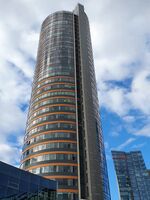
Vilnius is the major economic centre of Lithuania. The GDP per capita (nominal) in Vilnius metropolitan area (Vilnius County) is almost €30,000,[315] making it the wealthiest city in Lithuania and the second-wealthiest city in the Baltic states after Tallinn.
The budget of Vilnius reached €1.0 billion in 2022.[316] As of Q4 of 2022 the average monthly salary in Vilnius city municipality reached €2,115 (gross) and €1,307 (net).[317]
Since 2010, employment and unemployment indicators have continuously been improving in Lithuania. Employment reached a record high of 77.5% in the third quarter of 2018 while unemployment was 6.3% in the fourth quarter, a rate last observed in 2008. Nevertheless, this has to be seen in the context of a shrinking working age population. The activity rate reached 82% in 2017. Vilnius and Kaunas counties offer better labour market opportunities than other counties, and this drives the internal interregional migration. However, in other regions employment opportunities remain scarce. Unemployment rates remained persistently high in the least developed regions (14.9% in Utena County as compared to 4.8% in Vilnius County). Other key labour market indicators have improved, returning to pre-crisis levels. Long-term unemployment fell to 2.1% in the third quarter of 2018 (EU average: 2.9%). Youth unemployment (13.3%) and the rate of young people not in employment, education or training (NEET, at 9.1%) were below the EU average in 2017.[318]
Overall, the share of the population at risk of poverty or social exclusion (AROPE) has decreased since Lithuania joined the EU in 2004. However, it remains among the highest in the EU (29.6% in 2017, compared to 22.4% in the EU). The risk of poverty or social exclusion in rural areas is nearly double that of urban areas, which corresponds to the gap in the unemployment rate between cities and rural areas (4.5% versus 11% in 2017). In particular the metropolitan areas of Vilnius and Kaunas, where significant economic activity is centred, drive a significant gap between AROPE rates in urban and rural areas. In 2017, the AROPE rate in rural areas was 37.2%, compared to 19.9% in cities.[319]
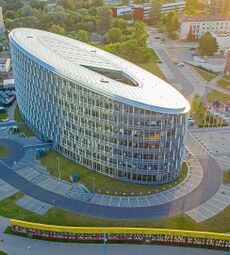
Over the past 15 years, Lithuania has experienced the fastest convergence in the EU, but the benefits of economic growth are uneven across regions. Disparities among Lithuania's regions have steadily grown in this period. While GDP per capita reached nearly 110% of the EU average in the capital region of Vilnius, it is only between 42% and 77% in other regions. The country's rapid convergence is mainly fuelled by two regions – the capital region of Vilnius and Kaunas County – producing 42% and 20% of the national GDP, respectively. In 2014–2016 these regions grew on average by 4.6% (Vilnius) and 3.3% (Kaunas), while the other regions, which have a higher share of rural areas, stagnated or were in recession.[321]
The supply of new housing in Vilnius and its suburbs, the country's biggest real estate market, has reached post-crisis highs and the stock of unsold apartments in the three largest cities has started to increase since the beginning of 2017. The demand for housing is still strong, fuelled by rapidly rising wages, benign financial conditions and positive expectations. In the first half of 2018, the number of monthly transactions was the highest since the 2007–2008 peak.[322] Most foreign direct investment and productive public investment in Lithuania is concentrated around the two main economic development poles of Vilnius and Kaunas.[323]
Vilnius Industrial Park is located 18.5 kilometres from the city and its land is intended for commercial, industrial use.[324]
العلوم والبحث
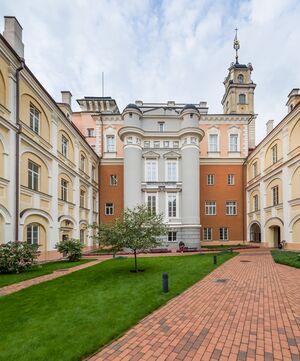
In 1675, Tito Livio Burattini lived in Vilnius and published a book Misura universale in which he suggested to use term metre for a unit of length for the first time.[325] In 1753, on the initiative of Thomas Zebrowski, the Vilnius University Astronomical Observatory was established, which was among the first observatories in Europe and the first in the Polish-Lithuanian Commonwealth.[326] Marcin Odlanicki Poczobutt led the reconstruction of the observatory in 1770–72 (according to Marcin Knackfus project) and made sure it was equipped with the latest astronomical instruments, from 1773 he began constant astronomical observations, which were recorded in the observation journals (فرنسية: Cahiers des observations), and created a constellation Taurus Poniatovii.[327] In 1781, Jean-Emmanuel Gilibert established the Botanical Garden of Vilnius University with over 2000 plants, he also provided the first herbariums, collections of stuffed animals and birds, fossil plants, animal remains, and a collection of minerals to Vilnius University.[328] After the Third Partition of the Commonwealth, the observatory published the first exact sciences journal in the Russian Empire called the Journal of Mathematical Sciences (روسية: Вестник математических наук).[172]
Sunrise Valley Science and Technology Park (لتوانية: Saulėtekio slėnio mokslo ir technologijų parkas) is a non-profit organization, founded in 2003. The park is the centre of entrepreneurship, promotion of business and science collaboration, provision of infrastructure and other innovation support. Over 20,000 students study in the Vilnius University and Vilnius Gediminas Technical University facilities in the Sunrise Valley, and 5,000 scientists performs their research in the corresponding science centres there.[329]
Centre for Physical Sciences and Technology (لتوانية: Fizinių ir technologijos mokslų centras) or FTMC is the largest scientific research institution in Lithuania, which specialises in laser technologies, optoelectronics, nuclear physics, organic chemistry, bio and nano technologies, electrochemical material science, electronics, and other scientific fields. The centre was created in 2010 by merging institutes of Chemistry, Physics, Semiconductor Physics in Vilnius and Textile institute in Kaunas.[330] The centre features 250 laboratories (24 open to the public) and can accommodate more than 700 researchers and students.[331] Furthermore, the centre also offers PhD Studies and annually helds FizTech conferences of PhD students and young researchers.[332] FTMC is the founder and sole shareholder of the Science and Technology Park of Institute of Physics in Savanorių Avenue, which provides assistance to companies operating in research and development field.[333]
Laser Research Centre of Vilnius University (لتوانية: Vilniaus universiteto Lazerinių tyrimų centras) is one of five departments in the Faculty of Physics, which prepares physicists, laser physicists and laser technology specialists. The department carries out research in laser physics, nonlinear optics, optical component characterization, biophotonics and laser microtechnology.[334] Lithuania is one of the world's leaders in producing laser technologies and has over 50% of the world's market share in ultrashort pulses lasers, which are produced by the Vilnius-based companies.[335] In 2019, they developed one of the world's most powerful laser system in the world SYLOS for the Extreme Light Infrastructure laboratory in Szeged, which produces high-intensity ultra-short pulses with a peak power of up to a thousand times that of the most powerful nuclear power plant in the United States.[335] Also, Corning Inc. has bought the licence for glass cutting from the Vilnius-based laser company Altechna and uses it for manufacturing Gorilla Glasses.[336]
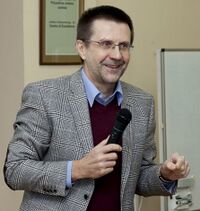
Vilnius University Life Sciences Centre (لتوانية: Vilniaus universiteto Gyvybės mokslų centras) is a scientific research centre, which consists of three institutes: Institute of Biochemistry, Institute of Biosciences and Institute of Biotechnology. The centre was opened in 2016 and has 800 students, 120 PhD students and 200 scientific-pedagogical staff that are able to use open access scientific laboratories equipped with the most advanced equipment there.[337] Next to the main building there is a Technology Business Incubator for small and medium businesses in life sciences or related fields.[338]
Vilnius Gediminas Technical University has three research centres in the Sunrise Valley: Civil Engineering Research Centre, Technology Centre for Building Information and Digital Modelling, Competence Centre of Intermodal Transport and Logistics.[339]
The Lithuanian Centre for Social Sciences (لتوانية: Lietuvos socialinių mokslų centras) in A. Goštauto St. 9 creates and disseminates scientific knowledge in the fields of economics, sociology and law in order to implement public policy. The Centre closely cooperates with the Government of Lithuania.[340]
Santara Valley (لتوانية: Santaros slėnis) is a second science and research valley in Vilnius, which focuses on the medicine, biopharmaceutical and bioinformatics areas.[341] Vilnius University Faculty of Medicine Science Centre, costing €37٫1 million, will be completed in the valley in 2021.[342]
Jonas Kubilius, long-term rector of Vilnius University, is known for works in Probabilistic number theory, Kubilius model, Theorem of Kubilius and Turán–Kubilius inequality bear his name. Jonas Kubilius successfully resisted attempts to Russify Vilnius University.[343] Vilnian Marija Gimbutas was the first to formulate the Kurgan hypothesis. In 1963, Vytautas Straižys and his coworkers created Vilnius photometric system that is used in astronomy.[344] Kavli Prize laureate Virginijus Šikšnys is known for his discoveries in CRISPR field – invention of CRISPR-Cas9 gene editing.[345]
تكنولوجيا المعلومات
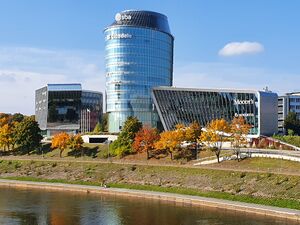
Lithuania and its capital Vilnius is an attractive place for foreign companies to open their offices. This is due to several main reasons – highly qualified employees and good infrastructure.[346] Several high schools are preparing skilled specialists in Vilnius, most notably the Vilnius University Faculty of Mathematics and Informatics and Vilnius Gediminas Technical University Faculty of Fundamental Sciences.[347][348] Sphere of the information technology is an attractive profession among the qualified professionals due to the high salaries in Vilnius (e.g. Lithuanian branch of Google, established in Vilnius, offers ~€17,800 monthly salary, which is one of the highest in Lithuania).[349] In 2018, the annual output of the information technology sector in Lithuania was €2٫296 billion, of which a large amount was created in Vilnius.[350]
Vilnius Tech Park in Sapieha Park is the biggest information technology startup hub in the Baltic and Nordic countries and unites international startups, technology companies, accelerators, incubators.[351] In 2019, the fDi Intelligence (an investment experts subdivision of the Financial Times) ranked Vilnius as number one city in the Tech Start-up FDI Attraction Index.[352]
In 2011, Vilnius had the fastest internet speed in the world[353] and despite the fall in the rankings in recent years – it still remained as one of the fastest around the globe.[354] Vilnius Airport also has one of the fastest wireless public internet (Wi-Fi) among the European airports.[355]
The National Cyber Security Centre of Lithuania was established in Vilnius due increasing internet attacks against the Lithuanian Government organizations.[356]
Bebras is an international informatics and information technology contest, which is held annually for pupils of 3–12 grades since 2004.[357] Since 2017, computer programming is taught in the primary schools.[358]
Lithuania and especially its capital Vilnius is a popular fintech companies hub due to the state's flexible regulations in the e-money licences field.[359] In 2018, Bank of Lithuania granted an electronic money licence to the Google Payment Lithuania company, based in Vilnius.[360] Since 2018, prominent e-money startup Revolut also has an e-money licence and headquarters in Vilnius, furthermore in 2019 it began to move its clients to the Lithuanian company Revolut Payments.[361] On 23 January 2019, the Europe's first international Blockchain Centre was opened in Vilnius.[362]
التمويل والمصارف
Vilnius is Lithuania's financial centre. The Ministry of Finance is located in Vilnius and is responsible for the development and enforcement of an efficient public financial policy with a view to ensuring the macroeconomic stability of the state and its economic growth.[363] The Bank of Lithuania is also headquartered in Vilnius and fosters a reliable financial system and ensures sustainable economic growth.[364] Nasdaq Vilnius Stock Exchange, a leading stock exchange in Lithuania, is located in K29 business centre in Konstitucijos Avenue.[365]
The National Audit Office of Lithuania (لتوانية: Lietuvos Respublikos valstybės kontrolė) is located in V. Kudirka Street and helps the state to manage public funds and property wisely.[366] While the State Tax Inspectorate (لتوانية: Valstybinė mokesčių inspekcija) is headquartered in Vasario 16-osios Street and is responsible for collecting or refunding taxes in the country.[367]
اعتبارا من 2023[تحديث], 13 banks in Lithuania are holding a bank or a specialised bank licence, while 6 banks are carrying out their activities as foreign bank branches. The majority of the Lithuanian financial system consists of capital banks of the Nordic countries.[368] The two largest banks registered in Lithuania (AB SEB bankas, Swedbank, AB,) are supervised directly by the European Central Bank jointly with Bank of Lithuania experts.[369]
الدين
| Religion | People | % |
|---|---|---|
| Roman Catholic | 350,797 | 65.5% |
| Eastern Orthodox | 47,827 | 8.9% |
| Old Believers | 5,593 | 1.0% |
| Evangelical Lutheran | 1,594 | 0.3% |
| Evangelical Reformed | 1,186 | 0.2% |
| Sunni Muslim | 798 | 0.2% |
| Jewish | 796 | 0.2% |
| Greek Catholic | 167 | <0.1% |
| Karaites | 139 | <0.1% |
| Other | 5,050 | 0.9% |
| None | 47,655 | 8.9% |
| No response | 74,029 | 13.8% |
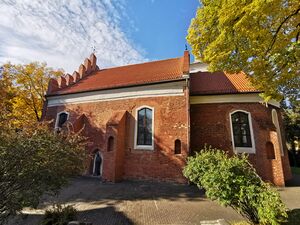
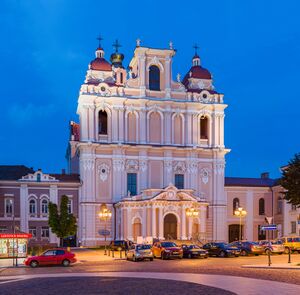
Already in the 17th century Vilnius was known as a city of many religions. In 1600, Samuel Lewkenor's book describing cities with universities was published in London.[371] Lewkenor mentions that citizens of Vilnius included Catholics, Orthodox, followers of John Calvin and Martin Luther, Jews and Tartar Muslims.
Throughout the 17th century Vilnius had a reputation as a city which had no rivals in Europe in the number of churches of different confessions. At the end of the century, this reputation was confirmed by the highly regarded (and several times republished) work by Robert Morden, "Geography Rectified or a Description of the World", which said that no other city in the world could surpass Vilnius in the number of churches and temples of various faiths, except perhaps Amsterdam.[372][373]
Today Vilnius is the seat of the Roman Catholic Archdiocese of Vilnius, with the main church institutions and Archdiocesan Cathedral (Vilnius Cathedral) located here. Numerous Christian Beatified persons, martyrs, Servants of God and Saints, are associated with Vilnius. These, among others, include Franciscan martyrs of Vilnius, Orthodox martyrs Anthony, John, and Eustathius, Saint Casimir, Josaphat Kuntsevych, Andrew Bobola, Raphael Kalinowski, Faustina Kowalska, Jurgis Matulaitis-Matulevičius.
There are a number of other active Roman Catholic churches in the city, along with small enclosed monasteries and religion schools. Church architecture includes Gothic, Renaissance, Baroque and Neoclassical styles, with important examples of each found in the Old Town. Additionally, Eastern Rite Catholicism has maintained a presence in Vilnius since the Union of Brest. The Baroque Basilian Gate is part of an Eastern Rite monastery.
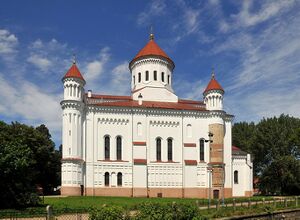
Vilnius has been home to an Eastern Orthodox Christian presence since the 13th or even the 12th century. A famous Russian Orthodox Monastery of the Holy Spirit, is near the [Gate of Dawn. St. Paraskeva's Orthodox Church in the Old Town is the site of the baptism of Hannibal, the great-grandfather of Pushkin, by Tsar Peter the Great in 1705. Many Old Believers, who split from the Russian Orthodox Church in 1667, settled in Lithuania. The Church of St. Michael and St. Constantine was built in 1913. Today a Supreme Council of the Old Believers is based in Vilnius.
A number of Protestant and other Christian groups[374] are represented in Vilnius, most notably the Lutheran Evangelicals and the Baptists.
The pre-Christian religion of Lithuania, centred on the forces of nature as personified by deities such as Perkūnas (the Thunder God), is experiencing some increased interest. Romuva established a Vilnius branch in 1991.[375]
Judaism and Karaism
Once widely known as Yerushalayim D'Lita (the "Jerusalem of Lithuania"), Vilnius, since the 18th century, was a world centre for Torah study, and had a large Jewish population. A major scholar of Judaism and Kabbalah centred in Vilnius was the famous Rabbi Eliyahu Kremer, also known as the Vilna Gaon. His writings have significant influence among Orthodox Jews to this day. The Vilna Shas, the most widely used edition of the Talmud was published in Vilnius in 1886.[376] Jewish life in Vilnius was destroyed during the Holocaust; there is a memorial stone dedicated to victims of Nazi genocide in the centre of the former Jewish Ghetto – now Mėsinių Street. The Vilna Gaon Jewish State Museum is dedicated to the history of Lithuanian Jewish life. The site of Vilnius's largest synagogue, built in the early 1630s and wrecked by Nazi Germany during its occupation of Lithuania, was found by ground-penetrating radar in June 2015, with excavations set to begin in 2016.[377][378]
The Karaites are a Jewish sect that migrated to Lithuania from the Crimea. Although their numbers are very small, the Karaites are becoming more prominent since Lithuanian independence, and have restored their kenesas (e.g. the Vilnius Kenesa).[379]
Pilgrimage
— From the speech of Pope John Paul II at the Dominican Church of the Holy Spirit during his visit to Lithuania in 1993.[380]
Since the Christianization of Lithuania in 1387, Vilnius has become one of the main centres of Christianity in Lithuania and a Christian pilgrimage site. Vilnius Pilgrimage Centre (لتوانية: Vilniaus piligrimų centras) coordinates pilgrimages, assists in their proper preparation, and takes care of pilgrimage pastoral care.[381] Many places in Vilnius are associated with divine miracles or marks significant events to the Christians. The Chapel of the Gate of Dawn is visited by thousands of Christian pilgrims annually. Initially, the gates were part of the defensive Wall of Vilnius, however in the 16th century they were given to the Carmelites, who installed a chapel in the gates with a prominent 17th century Catholic painting Our Lady of the Gate of Dawn. The painting was later decorated with gold-plated silver embellishments and is surrounded by a legend and divine miracles.[382]

Sanctuary of the Divine Mercy is another important pilgrimage site, which has the Divine Mercy image. Vilnius became the birthplace of the Divine Mercy devotion when Saint Faustina began her mission under the guidance and discernment of her new spiritual director, blessed Michał Sopoćko. In 1934, the first Divine Mercy image was painted by Eugeniusz Kazimirowski under the supervision of Faustina Kowalska and it presently hangs in the Divine Mercy Sanctuary in Vilnius. A feast of the Adoration of the Blessed Sacrament is held in the shrine 24 hours per day.[382] The House of St. Faustina where she previously lived is located in V. Grybo St. in Antakalnis and is open to the pilgrims every day.[383]
Church of St. Philip and St. Jacob near the Lukiškės Square has the painting of the Mother of God of Lukiškės, which is glorified by divine miracles.[382] The icon was painted in the 15th – 16th centuries and is one of the oldest monuments of easel painting in Lithuania.[384] It was brought by the Grand Duchy of Lithuania artillery general Motiejus Korvinas Gosievskis from the Russo-Polish War. From 1684 onwards miracles began to be experienced in the Vilnius Dominican Monastery, related to the image of Mother of God of Lukiškės, which in 1737 were published in a miracles book Mystical fountain (لتوانية: Mistinis fontanas). The icon was restored and returned to the Dominicans in 2012.[385]
Three Crosses is a prominent monument in Vilnius. According to a debated legend of the Franciscan martyrs of Vilnius, presented in the Bychowiec Chronicle, fourteen Franciscan friars were invited to Vilnius from Podolia by Petras Goštautas.[386] The friars publicly preached the gospel and denigrated the pagan Lithuanian gods. Angered city residents burned the monastery and killed all fourteen friars. Seven of them were beheaded on the Bleak Hill; the other seven were crucified and thrown into the Neris or Vilnia River.[386]
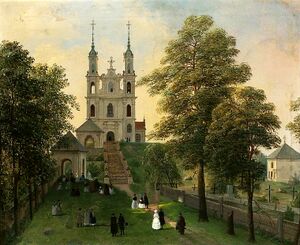
Verkiai Calvary (or Vilnius Calvary) is the second oldest calvary in Lithuania after Žemaičių Kalvarija. It is located in Verkiai, a neighborhood of Vilnius. The Calvary was built in 1662–69 as a sign of gratitude for the victory in the Second Northern War (1655–60).[387] The consecration ceremony of the new Stations of the Cross took place at Pentecost on 9 June 1669.[388] The Calvary includes 20 brick chapels, seven wooden and one brick gate, and one bridge with a wooden chapel.[389] The path ends at the Church of the Discovery of the Holy Cross. In 1962 all chapels, except four closest to the church, were destroyed by the Soviet authorities with dynamites overnight. The Calvary was reconstructed in 1990–2002 and the chapels were solemnly consecrated at Pentecost in 2002.[390] Pilgrimages in the Calvary are organized regularly with the clergy.[391]
Church Heritage Museum (لتوانية: Bažnytinio paveldo muziejus) exhibits the oldest and largest of all the churches of the Grand Duchy of Lithuania treasure trove of the Vilnius Cathedral and liturgical artefacts from other churches of the Roman Catholic Archdiocese of Vilnius.[382][392]
Vilnius is the only city in the Baltic states with an Apostolic Nunciature, in which Pope John Paul II and Pope Francis stayed during their visits to Lithuania, Latvia and Estonia.[393]
النقل
مدن شقيقة
مدينة ڤلنيوس لها علاقات شراكة مع 14 مدينة. بالإضافة إلى اتفاقيات تعاون مع 16 مدينة أخرى.
التقسيمات الفرعية
انظر ايضا
- مطرانية ڤلنيوس
- ميدان الكاتدرائية في ڤلنيوس
- شعار مدينة ڤلنيوس
- قلعة گديميناس
- Elektrit
- Kaziuko fair in Vilnius
- Pilies Street
- كاتدرائية فيلنيوس
- ماراثون ڤلنيوس
- جامعة ڤلنيوس
- قائمة الڤلنيين
- ڤلنا گاعون
- گـِتو ڤلنا
وصلات خارجية
| Vilnius
]].- Chronicles of the Vilna Ghetto: wartime photographs & documents — vilnaghetto.com
- Official city guide
- Vilnius during the Holocaust
- Vilnius Public Transport System
- ^ "Vilnius: In Search of the Jerusalem of Lithuania – Lithuanian Jewish Community". lzb.lt. 18 November 2016. Retrieved 5 March 2021.
- ^ Widespread use of the nickname from the 16th century to this day as a reference to the many Catholic churches and monasteries in Vilnius and overall religious atmosphere in the centre. This nickname was/is used not only by the foreigners but also by the local population. The 19th-century Lithuanian cultural figure Dionizas Poška nicknamed Vilnius "Rome of the North", as, according to him, Vilnius is "the old religious centre, that transformed from a pagan city into the bastion of Christianity". D. Poška, 'Raštai', Vilnius, 1959, p. 67
- ^ Cultural newspaper, that has been published in Vilnius since 1990, is named "Šiaurės Atėnai" (The Athens of the North) as a reference to one of Vilnius's nicknames, which was widespread in the first half of the 19th century and the first half of the 20th, mostly because of Vilnius University. During the interwar period, a Polish scientific newspaper published in Vilnius was also named "Atheneum Wileńskie".
- ^ Especially in the 16th–17th centuries, Vilnius was called the ‘New Babylon’ because of the many languages spoken there as well as its many religions (there were various Christian communities as well as Jews and a Muslim Tatar community). E.g.: S. Bodniak, "Polska w relacji włoskiej z roku 1604", Pamiętnik biblioteki kórnickiej, 2, (Kórnik, 1930), p. 37.
- ^ This nickname was very popular among the Lithuanian nobility, citizens of Vilnius and poets, especially during the Baroque period. Many poets of the period, including Maciej Kazimierz Sarbiewski, nicknamed Vilnius "the capital of Palemon" or "the city of Palemon". Živilė Nedzinskaitė, Vilnius XVII–XVIII a. LDK lotyniškojoje poezijoje, Acta Academiae Artium Vilnensis, Vilnius, 2010, p. 16; Eugenija Ulčinaitė, Motiejus Kazimieras Sarbievijus: Antikos ir krikščionybės sintezė; Vilniaus pasveikinimas, Lietuvių literatūros ir tautosakos institutas, Vilnius, 2001, pp. 47, 59, 61, 63; etc.
- ^ with Vilnius district municipality
- ^ "Population on 1 January by age groups and sex - functional urban areas". appsso.eurostat.ec.europa.eu. Retrieved 14 June 2022.
- ^ "Gyventoju skaicius pagal savivaldybes" (PDF). Registrucentras.lt. 2022-01-05. Retrieved 28 February 2022.
- ^ خطأ استشهاد: وسم
<ref>غير صحيح؛ لا نص تم توفيره للمراجع المسماةpop.lt - ^ "Statistinių rodiklių analizė". Statistics Lithuania.
- ^ "Vilniaus biudţeto planas 2022-iesiems – minus 96,7 mln. Eur" [Vilnius budget plan for 2022 - minus 96.7 million. Eur]. Verslo ţinios (in الليتوانية). 2022-01-10. Retrieved 2022-02-28.
- ^ Sub-national HDI. "Area Database – Global Data Lab". hdi.globaldatalab.org.
- ^ "Vilnius Historic Centre". UNESCO World Heritage Centre. Retrieved 2022-01-01.
- ^ "The World According to GaWC 2020". GaWC - Research Network. Globalization and World Cities. Retrieved 31 August 2020.
- ^ "Lithuania". UNESCO World Heritage Centre. Archived from the original on 14 January 2018.
- ^ Steele, Jonathan (19 June 2008). "In the Jerusalem of the North, the Jewish story is forgotten". Opinion. The Guardian. Archived from the original on 14 January 2018. Retrieved 4 March 2018.
- ^ "Ex-Post Evaluation of 2009 European Capitals of Culture" (PDF). ECOTEC Research and Consulting Ltd. Archived (PDF) from the original on 14 January 2018.
- ^ "fDi's Global Cities of the Future 2021/22 — overall winners". fdiintelligence. fDi Intelligence A service from The Financial Times Ltd. Retrieved 22 March 2021.
- ^ "Portrait of the Regions of Lithuania – Vilnius city municipality". Department of Statistics. Archived from the original on 22 July 2015. Retrieved 1 August 2015.
- ^ Лавринец, Павел (20 October 2004). Русская Вильна: идея и формула. Балканская Русистика (in الروسية). Вильнюс. Retrieved 18 August 2009.
- ^ Васютинский, А.М.; Дживелегов, А.К.; Мельгунов, С.П. (1912). "Фон Зукков, По дороге в Вильно". Задруга Французы в России. 1812 г. По воспоминаниям современников-иностранцев. (in الروسية). Vol. 1–3. Москва. Retrieved 18 August 2009.
{{cite book}}: CS1 maint: location missing publisher (link) - ^ "The Legend of the Founding of Vilnius - Gediminas Dream". Ironwolf.lt. Retrieved 28 February 2022.
- ^ أ ب Tiukšienė, Zita; Sisaitė, Nijolė (2015). Pasižvalgymai po Vilnių (PDF). Vilnius: Adomo Mickevičiaus viešoji biblioteka. p. 167.
- ^ أ ب ت ث ج ح خ د ذ ر ز س ش ص ض ط ظ ع غ ف ق "Vilniaus istorija". vle.lt (in الليتوانية). Retrieved 8 November 2019.
- ^ Rowell, Stephen Christopher (2003). Chartularium Lithuaniae res gestas magni ducis Gedeminne illustrans – Gedimino laiškai (PDF). Vilnius: Leidykla Vaga. Retrieved 7 June 2017.
- ^ "Algirdas". vle.lt. Retrieved 24 April 2020.
- ^ Briedis 2009, p. 20.
- ^ Given-Wilson, Chris (2016). Henry IV. English Monarchs series. Yale University Press. p. 69. ISBN 978-0300154207.
- ^ Basilevsky, Alexander (2016). Early Ukraine: A Military and Social History to the Mid-19th Century. McFarland. pp. 178–179. ISBN 978-1476620220. Retrieved 11 November 2019.
- ^ Tautavičius, Adolfas. "Žygimanto Augusto lobyno likimas" (PDF). lad.lt (in الليتوانية). p. 111. Retrieved 20 December 2020.
- ^ "Žygimantas Augustas". Vle.lt (in الليتوانية). Retrieved 20 December 2020.
- ^ "History". Vilnius University. Retrieved 10 July 2019.
- ^ Briedis 2009, p. 59.
- ^ أ ب ت ث ج ح خ د ذ ر ز س ش ص ض "Vilniaus istorija". Vle.lt (in الليتوانية). Retrieved 10 March 2023.
- ^ Briedis 2009, p. 246-247.
- ^ أ ب "Vilniaus gynimas". vle.lt. Retrieved 12 November 2019.
- ^ أ ب ت "Aleksandras I". Vle.lt (in الليتوانية). Retrieved 10 March 2023.
- ^ "Prancūzijos imperatorius Napoleonas Bonapartas su savo Didžiąja Armija". Lietuvos valstybės istorijos archyvas (in الليتوانية). Archived from the original on 10 March 2023. Retrieved 10 March 2023.
- ^ Briedis 2009, p. 59-60.
- ^ Piotr S. Wandycz, The lands of partitioned Poland, 1795–1918, University of Washington Press, 1974, pg. 166.
- ^ Aleksandravičius, Egidijus; Kulakauskas, Antanas (1996). Carų valdžioje: Lietuva XIX amžiuje [Under the Tzars: Lithuania in the 19th Century] (in الليتوانية). Vilnius: Baltos lankos. Archived from the original on 12 August 2006. Polish translation: Pod władzą carów: Litwa w XIX wieku, Universitas, Kraków 2003, pg. 90; ISBN 83-7052-543-1
- ^ Hoerder, Dirk; Blank, Inge; Rössler, Horst (1994). Roots of the Transplanted. East European Monographs. p. 69. ISBN 978-0880332880.
- ^ Zimmerman, Joshua D. (26 January 2004). Poles, Jews, and the Politics of Nationality: The Bund and the Polish Socialist Party in Late Tsarist Russia, 1892–1914. Univ of Wisconsin Press. p. 16. ISBN 978-0-299-19463-5.
- ^ Snyder, Timothy (2003). The Reconstruction of Nations. Poland, Ukraine, Lithuania, Belarus 1569–1999. Yale University Press. p. 306. ISBN 978-0-300-10586-5.
A 1909 official count of the city found 205,250 inhabitants, of whom 1.2 percent were Lithuanian; 20.7 percent Russian; 37.8 percent Polish; and 36.8 percent Jewish.
- ^ Vardys, Vytas Stanley; Sedaitis, Judith B. (1997). Lithuania: The Rebel Nation. Westview Series on the Post-Soviet Republics. WestviewPress. pp. 19–20. ISBN 0-8133-1839-4.
- ^ Eidintas, Alfonsas; Žalys, Vytautas; Senn, Alfred Erich (1999). Ed. Edvardas Tuskenis (ed.). Lithuania in European Politics: The Years of the First Republic, 1918–1940 (Paperback ed.). New York: St. Martin's Press. pp. 17–18. ISBN 0-312-22458-3.
- ^ "The First German Occupation, 1915–1918" (PDF). Archived from the original (PDF) on 14 January 2018.
- ^ "Lithuania finds lost declaration of independence". World. The Guardian. 30 March 2017. Archived from the original on 14 January 2018.
- ^ Łossowski, Piotr (1995). Konflikt polsko-litewski 1918–1920 (in البولندية). Warszawa: Książka i Wiedza. pp. 126–128. ISBN 83-05-12769-9.
- ^ Abdelal, Rawi (2001). National Purpose in the World Economy: Post-Soviet States in Comparative Perspective. Cornell University Press. ISBN 978-0-8014-8977-8.
At the same time, Poland acceded to Lithuanian authority over Vilnius in the 1920 Suwałki Agreement.
- ^ Price, Glanville (1998). Encyclopedia of the Languages of Europe. Blackwell Publishing. ISBN 978-0-8014-8977-8.
In 1920, Poland annexed a third of Lithuania's territory (including the capital, Vilnius) in a breach of the Treaty of Suvalkai of 7 October 1920, and it was only in 1939 that Lithuania regained Vilnius and about a quarter of the territory previously occupied by Poland.
- ^ Smith, David James; Pabriks, Artis; Purs, Aldis; Lane, Thomas (2002). The Baltic States. Routledge. ISBN 978-0-415-28580-3.
Fighting continued until the agreement at Suwałki between Lithuania and Poland on 7 October 1920, which drew a line of demarcation which was incomplete but indicated that the Vilnius area would be part of Lithuania
- ^ Eudin, Xenia Joukoff; Fisher, Harold H.; Jones, Rosemary Brown (1957). Soviet Russia and the West, 1920–1927. Stanford University. p. 9. ISBN 978-0-8047-0478-6.
The League effected an armistice, signed at Suwałki, 7 October 1920, by the terms of which the city was to remain under Lithuanian jurisdiction.
- ^ Eidintas, Alfonsas; Tuskenis, Edvardas; Zalys, Vytautas (1999). Lithuania in European Politics. Macmillan. ISBN 978-0-312-22458-5.
The Lithuanians and the Poles signed an agreement at Suwałki on 7 October. Both sides were to cease hostilities and to peacefully settle all disputes. The demarcation line was extended only in the southern part of the front, to Bastunai. Vilnius was thus left on the Lithuanian side, but its security was not guaranteed.
- ^ Abramowicz, Hirsz; Dobkin, Eva Zeitlin; Shandler, Jeffrey; Fishman, David E. (1999). Profiles of a Lost World: Memoirs of East European Jewish Life Before World War II. Wayne State University Press. ISBN 978-0-8143-2784-5.
Before long there was a change of authority: Polish legionnaires under the command of General Lucian Zeligowski 'did not agree' with the peace treaty signed with Lithuania in Suwałki, which ceded Vilna to Lithuania.
- ^ Brecher, Michael; Wilkenfeld, Jonathan (1997). A Study of Crisis. University of Michigan Press. ISBN 978-0-472-10806-0.
Mediation by the League Council led to an agreement on the 20th providing for a cease-fire and Lithuania's neutrality in the Polish–Russian War; Vilna remained part of Lithuania. The (abortive) Treaty of Suwałki, incorporating these terms, was signed on 7 October.
- ^ Buell, Leslie (2007). Poland: Key to Europe. Alfred Knopf, republished by Read Books. ISBN 978-1-4067-4564-1.
Clashes subsequently took place with Polish troops, leading to the armistice at Suwałki in October 1920 and the drawing of the famous Curzon Line under League mediation, which allotted Vilna to Lithuania.
- ^ Slocombe, George (1970). Mirror to Geneva. Ayer Publishing. ISBN 978-0-8369-1852-6.
Zeligowski seized the city in October 1920, in flagrant violation not only of the Treaty of Suwałki signed by Poland and Lithuania two days earlier, but also of the covenant of the newly created League of Nations.
- ^ "Prieš 100 metų lenkai užėmė Vilnių: kad jis vėl bus Lietuvos sostine, galėjo tikėti tik don kichotai". Lrt.lt (in الليتوانية). 19 April 2019. Retrieved 22 September 2019.
- ^ Tylińska, Ewelina. "The revival of the Vilnius University in 1919: Historical conditions and importance for Polish science" in 2nd ICESHS (Cracow, Poland, September 6–9, 2006). M. Kokowski.
- ^ Müller, Jan-Werner (2002). Memory and Power in Post-War Europe: Studies in the Presence of the Past. Cambridge University Press. p. 47. ISBN 978-0-5210-0070-3.
- ^ Gross, Jan Tomasz (2002). Revolution from Abroad: The Soviet Conquest of Poland's Western Ukraine and Western Belorussia. Princeton University Press. p. 3. ISBN 978-0-6910-9603-2.
- ^ Tyla, Antanas (6 October 2011). "Suvalkų sutartis ir jos išniekinimas". Alkas.lt (in الليتوانية).
- ^ Macukonienė, Janina (2022). "Nepamirškime skaudžių mūsų tautos istorijos faktų" (PDF). Aušra (in الليتوانية). 2 (843): 19–21.
- ^ Ereminas, Gintautas. "Lenkijos valdžios polonizacijos politika prieš lietuvių tautinę mažumą (1935–1939 m.)". Genocid.lt (in الليتوانية).
- ^ Januszewska-Jurkiewicz, Joanna (2005). "Koncepcje programowe działaczy Obozu Zjednoczenia Narodowego Okręgu Wileńskiego i Nowogródzkiego w kwestii białoruskiej". Białoruskie Zeszyty Historyczne (in البولندية). 23: 192–212.
- ^ Burauskaitė, Birutė. "Vilniaus krašto ir Vakarų Baltarusijos lenkų, baltarusių, lietuvių ir žydų bendruomenės istorijos verpetuose 1939–1944 m. Mitai ir stereotipai". Genocid.lt (in الليتوانية).
- ^ Iškauskas, Česlovas. "Č. Iškauskas. Galingųjų vizitai Lietuvoje: Napoleonas, Hitleris, Putinas". DELFI. Retrieved 24 September 2019.
- ^ "Kultūrų kryžkelė. Menora (2014.10.30)". Lrt.lt. 2014-10-30. Retrieved 12 November 2019.
- ^ Krauski, Josef (1992). "Education as Resistance: The Polish Experience of Schooling During the War". In Lowe, Roy (ed.). Education and the Second World War : studies in schooling and social change. Falmer Press. p. 130. ISBN 0-7507-0054-8.
- ^ Mačiulis & Staliūnas 2015, p. 169-170.
- ^ Snyder, Timothy (2003). The Reconstruction of Nations: Poland, Ukraine, Lithuania, Belarus, 1569–1999. Yale University Press. p. 83. ISBN 978-0-300-12841-3.
- ^ Misiunas, Romuald J.; Taagepera, Rein (1993). The Baltic States: Years of Dependence 1940–1990 (expanded ed.). University of California Press. p. 47. ISBN 978-0-520-08228-1.
- ^ Yitzhak Arad, Encyclopedia of the Holocaust, vol. 4, p. 1572
- ^ Anušauskas, Arvydas; et al., eds. (2005). Lietuva, 1940–1990 (in الليتوانية). Vilnius: Lietuvos gyventojų genocido ir rezistencijos tyrimo centras. p. 177. ISBN 978-9986-757-65-8.
- ^ Tourism, Vilnius (1 September 2011). "The Big and Little Ghetto – Vilnius Tourist Information Centre".
- ^ "Mažasis ir Didysis Vilniaus žydų getai" (in الليتوانية). Archived from the original on 3 March 2016.
- ^ Marrus, Michael R. The Holocaust in History. Hanover: University Press of New England, 1987, p. 108.
- ^ Borodziej, Włodzimierz (2006). The Warsaw Uprising of 1944. Translated by Harshav, Barbara. University of Wisconsin Press. p. 55. ISBN 978-0-299-20730-4.
Operation Ostra Brama, however, turned out to be a failure.
- ^ "Kovos dėl Vilniaus 1944 liepą" (in الليتوانية). Archived from the original on 28 September 2011. Retrieved 10 November 2013.
- ^ Bubnys, Arūnas. "NKGB–NKVD prieš lenkų pogrindį Lietuvoje 1944 m. antroje pusėje–1945 m. pirmoje pusėje". genocid.lt. Retrieved 25 September 2019.
- ^ "Pokario areštai ir trėmimai (1944–1948 m. pradžia)". lnm.lt (in الليتوانية). Retrieved 25 September 2019.
- ^ Briedis 2009, p. 228.
- ^ Daraškevičius, Vytautas. "Michailo Gorbačiovo vizitas Vilniuje 1990 m. sausį ir Tautos Sueiga". 15min.lt (in الليتوانية). Retrieved 4 February 2023.
- ^ Robertas Bernotas (2020-01-10). "Lina Būgienė. Pokario Vilnius jo gyventojų akimis (I)". Literaturairmenas.lt. Retrieved 2022-01-01.
- ^ Robertas Bernotas (2020-01-24). "Lina Būgienė. Pokario Vilnius jo gyventojų akimis (II)". Literaturairmenas.lt. Retrieved 2022-01-01.
- ^ "Įmonės istorija". Vilniausviesasistransportas.lt. Retrieved 26 March 2023.
- ^ "Lietuvos Nepriklausomos Valstybės Atkūrimas (1990 M. Kovo 11 D.)" (in الليتوانية). Archived from the original on 10 November 2013. Retrieved 10 November 2013.
- ^ Siaurusevicius, Audrius (14 January 1991). "Soviet tanks crush the human shield of Vilnius". World. The Guardian. Archived from the original on 14 January 2018.
- ^ Schmemann, Serge (7 September 1991). "Soviet Turmoil; Soviets Recognize Baltic Independence, Ending 51-year Occupation of 3 Nations". The New York Times. Retrieved 2021-02-16.
- ^ "Pastatytų butų kiekis ne rekordinis, tačiau didžiausias per pastaruosius 10 metų". Ober-Haus Nekilnojamasis Turtas (in الليتوانية). 17 January 2019. Retrieved 5 March 2021.
- ^ "Gyvenamosios teritorijos" (PDF). vilnius.lt (in الليتوانية). Retrieved 5 March 2021.
- ^ "Gyvenamojo nekilnojamojo turto rinkos komentaras" (PDF). ober-haus.lt (in الليتوانية). Retrieved 5 March 2021.
- ^ "Cultural capitals of Europe". Chicago Tribune. 11 January 2009. Retrieved 12 January 2009.[dead link]
- ^ O. Niglio. "Restauri in Lituania. Vilnius Capitale della Cultura Europea 2009" [Restorations in Lithuania. Vilnius Capital of European Culture 2009] (PDF). Web Journal on Cultural Patrimony (in الإيطالية). ISSN 1827-8868. Archived from the original (PDF) on 9 December 2013. Retrieved 9 November 2006.
- ^ Greenhalgh, Nathan. "Capital of Culture: success or failure?". Retrieved 15 May 2011.
- ^ "A.Gelūnas: prokuratūra nusikaltimo rengiant Bjork koncertą neįžvelgė". Retrieved 15 May 2011.
- ^ "Vilnius: artists protest 'breakdown of culture' in EU cultural capital". cafebabel.com. Archived from the original on 26 July 2011. Retrieved 15 May 2011.
- ^ Burke, Jason (18 January 2009). "Eastern Europe braced for a violent 'spring of discontent'". The Guardian. London.
- ^ "Balsavimo rezultatai". 2013.vrk.lt. 22 March 2015. Archived from the original on 18 May 2016. Retrieved 26 September 2015.
- ^ "Eastern Partnership Summit in Vilnius begins" (Press release). Ministry of Foreign Affairs of the Republic of Lithuania. 29 November 2013.
- ^ "Strategic Eastern Partnership agreements signed in Vilnius" (Press release). Ministry of Foreign Affairs of the Republic of Lithuania. 29 November 2013.
- ^ "Lithuania to host 2023 NATO summit, first event 'of such a scale'". Lrt.lt. 15 June 2021. Retrieved 15 June 2021.
- ^ أ ب "The geographical Centre of Europe". visitlithuania.net. Archived from the original on 4 November 2019. Retrieved 4 November 2019.
- ^ Krogh, Jan S. "Other Places of Interest: Central Europe".
- ^ "The City". City of Vilnius. Archived from the original on 16 December 2008. Retrieved 30 January 2009.
- ^ "Gamtos paveldo apsauga". vilnius.lt. Retrieved 4 November 2019.
- ^ Kottek M, Grieser J, Beck C, Rudolf B, Rubel F (2006). "World Map of the Köppen-Geiger climate classification updated" (PDF). Meteorol. Z. 15 (3): 259–263. Bibcode:2006MetZe..15..259K. doi:10.1127/0941-2948/2006/0130.
- ^ Bradley, Raymond S.; Jones, Philip D. (1995). Climate Since A.D. 1500. Routledge. ISBN 978-0-415-12030-2.
- ^ "Climate change in Lithuania". Lithuanian Hydrometeorological Service under the Ministry of Environment. Archived from the original on 19 August 2014. Retrieved 18 August 2014.
- ^ "Lithuanian Hydrometeorological Service". meteo.lt. Retrieved 7 August 2020.
- ^ "(إنگليزية) Weather Information for Vilnius".
{{cite web}}: Unknown parameter|accessmonthday=ignored (help); Unknown parameter|accessyear=ignored (|access-date=suggested) (help) - ^ أ ب ت ث ج ح خ "Lietuvos tapyba". vle.lt (in الليتوانية). Retrieved 10 November 2019.
- ^ أ ب ت ث "Lietuvos skulptūra". vle.lt (in الليتوانية). Retrieved 10 November 2019.
- ^ "Vilniaus meno mokykla". alka.mch.mii.lt. Archived from the original on 2 December 2019. Retrieved 10 November 2019.
- ^ "Lietuvių dailės draugija". vle.lt. Retrieved 10 November 2019.
- ^ "Vilniaus dailės draugija". vle.lt. Retrieved 10 November 2019.
- ^ Griffin, Joanna (8 August 2016). "Just Back: Inside Uzupis, Lithuania's free-thinking republic". Travel. The Telegraph. Archived from the original on 14 January 2018.
- ^ "Frank Zappa Memorial". lonely planet.
- ^ "Vilnius Talking Statues". vilnius-tourism.lt. 2015-06-19. Retrieved 10 November 2019.
- ^ أ ب "Museums". GoVilnius.lt. Retrieved 29 April 2023.
- ^ "The Palace of the Grand Dukes of Lithuania". GoVilnius.lt. Retrieved 29 April 2023.
- ^ "The New Arsenal". GoVilnius.lt. Retrieved 29 April 2023.
- ^ "The Old Arsenal". GoVilnius.lt. Retrieved 29 April 2023.
- ^ "The Museum of Applied Arts and Design". GoVilnius.lt. Retrieved 29 April 2023.
- ^ "M.K. Čiurlionio namai". Ciurlioniokelias.lt (in الليتوانية). Retrieved 29 April 2023.
- ^ "Collections". ldm.lt. Archived from the original on 10 November 2019. Retrieved 10 November 2019.
- ^ "Permanent exhibitions". ldm.lt. Archived from the original on 10 November 2019. Retrieved 10 November 2019.
- ^ "Collection". ndg.lt. Retrieved 10 November 2019.
- ^ "About the CAC". cac.lt. Retrieved 10 November 2019.
- ^ "About us". mekas.lt. 25 July 2014. Retrieved 10 November 2019.
- ^ "About MO". mo.lt. Retrieved 23 April 2019.
- ^ "Biography of Skaryna". Web1.mab.lt. Retrieved 29 October 2019.
- ^ "Vilnius University Press – History". vu.lt. Retrieved 29 October 2019.
- ^ "Zawadzkio spaustuvė". vle.lt. Retrieved 29 October 2019.
- ^ "Adomas Mickevičius". vle.lt. Retrieved 30 October 2019.
- ^ Lebedys, Jurgis. "Mikalojus Daukša". postilla.mch.mii.lt. Archived from the original on 24 April 2007. Retrieved 29 October 2019.
- ^ "Vilnius University Hinc Itur Ad Astra" (PDF). 20 October 2015: 25. Retrieved 29 October 2019.
{{cite journal}}: Cite journal requires|journal=(help) - ^ "Lietuvos Statutas". vle.lt. Retrieved 29 October 2019.
- ^ أ ب Dubonis, Artūras. "Lietuvių kalba: poreikis ir vartojimo mastai (XV a. antra pusė – XVI a. pirma pusė)". viduramziu.istorija.net (in الليتوانية). Archived from the original on 3 March 2016. Retrieved 22 September 2019.
- ^ "Lietuvos Metrika". vle.lt. Retrieved 30 October 2019.
- ^ "Literatų Gatvė (Literature Street)". atlasobscura.com. Retrieved 17 November 2019.
- ^ "About". llti.lt. Retrieved 29 October 2019.
- ^ "Lithuanian Writers Union". rasytojai.lt. Retrieved 29 October 2019.
- ^ "Vilnius Book Fair". vilniausknygumuge.lt. Archived from the original on 2 November 2019. Retrieved 2 November 2019.
- ^ أ ب "Vilniaus kino istorija: pirmasis seansas tik pusmečiu atsiliko nuo pirmojo istorijoje". Lrt.lt (in الليتوانية). 27 November 2015. Retrieved 22 September 2019.
- ^ أ ب ت "Vilniaus kino teatrai 1905–1985 metais". MadeinVilnius.lt (in الليتوانية). 1 May 2017. Retrieved 22 September 2019.
- ^ "Vilniuje neliko istorinio kino teatro "Lietuva"". 15min.lt (in الليتوانية). Retrieved 22 September 2019.
- ^ "About Festival". kinopavasaris.lt. Retrieved 14 October 2019.
- ^ "About us". lkc.lt. Retrieved 22 September 2019.
- ^ "Operą Vilnius išvydo pirmiau negu Londonas ir Paryžius". valdovurumai.lt. 12 April 2011. Retrieved 26 April 2020.
- ^ "Lietuvos muzika". vle.lt. Retrieved 21 February 2021.
- ^ "Žygimantas Liauksminas". vle.lt. Retrieved 23 January 2020.
- ^ "Operos dieną Valdovų rūmuose vainikuos pasaulinis šedevras – K. Monteverdžio opera "Orfėjas"". valdovurumai.lt. Archived from the original on 8 March 2021. Retrieved 7 September 2015.
- ^ "Repertoire". opera.lt. Retrieved 31 October 2019.
- ^ "History – Largest Concert Institution in Lithuania". Lithuanian National Philharmonic Society. Retrieved 3 February 2017.
- ^ "About us". lvso.lt. Retrieved 31 October 2019.
- ^ Murauskaitė, Rasa. "Trys meilės chorui dešimtmečiai. Pokalbis su Vaclovu Augustinu". 15min.lt (in الليتوانية). Retrieved 31 October 2019.
- ^ "Lithuanian Song Festival". DainuSvente.lt. Archived from the original on 11 June 2021. Retrieved 23 January 2018.
- ^ Masterpieces of the Oral and Intangible Heritage of Humanity (PDF). UNESCO. 2005. p. 50.
- ^ "Jazz in Lithuania". Vilniusjazz.lt. Retrieved 25 March 2018.
- ^ "Street Music Day". gmd.lt. Archived from the original on 11 March 2018. Retrieved 10 March 2018.
- ^ "Dainavimo katedra". lmta.lt (in الليتوانية). Retrieved 31 October 2019.
- ^ "Seniausių laikų Lietuvos teatras". vle.lt. Retrieved 17 November 2019.
- ^ "Mokyklinis teatras Lietuvos teritorijoje". vle.lt. Retrieved 17 November 2019.
- ^ أ ب ت ث "Lietuvos teatras". vle.lt. Retrieved 17 November 2019.
- ^ "Vilniaus miesto teatras". vle.lt. Retrieved 17 November 2019.
- ^ "Juliusz Osterwa". vle.lt. Retrieved 24 December 2019.
- ^ "Events". teatrai.lt. Retrieved 17 November 2019.
- ^ أ ب ت ث ج "Lietuvos meninė fotografija". vle.lt (in الليتوانية). Retrieved 21 February 2021.
- ^ "Stanislovas Filibertas Fleris". limis.lt (in الليتوانية). Retrieved 7 March 2021.
- ^ أ ب Klimka, Libertas (20 June 2001). Senosios Vilniaus astronomijos observatorijos instrumentarijus (PDF) (in الليتوانية). Vilnius: Lithuanian University of Educational Sciences. p. 44. Retrieved 21 February 2021.
- ^ "Vilniaus fotoklubas". vle.lt (in الليتوانية). Retrieved 21 February 2021.
- ^ "Lobyno vertybės". katedra.lt (in الليتوانية). Retrieved 21 February 2021.
- ^ أ ب ت "Amatai". vle.lt (in الليتوانية). Retrieved 21 February 2021.
- ^ "Vilniaus auksakalių cechas". vle.lt (in الليتوانية). Retrieved 21 February 2021.
- ^ "Vilniaus monetų kalykla". vle.lt (in الليتوانية). Retrieved 21 February 2021.
- ^ أ ب ت "Raštas ir kalbos viduramžių Lietuvoje". viduramziu.istorija.net (in الليتوانية). Retrieved 22 September 2019.
- ^ Pancerovas, Dovydas. "Ar perrašinėjamos istorijos pasakų įkvėpta Baltarusija gali kėsintis į Rytų Lietuvą?". 15min.lt (in الليتوانية). Retrieved 1 October 2014.
- ^ Statkuvienė, Regina. "Jogailaičiai. Kodėl ne Gediminaičiai?". 15min.lt (in الليتوانية). Retrieved 9 November 2018.
- ^ "Kurie Lietuvos valdovai mokėjo protėvių kalbą, kurie – ne? / Laida "Lietuva – mūsų lūpose"". YouTube (in الليتوانية). Palace of the Grand Dukes of Lithuania. Archived from the original on 2021-12-11. Retrieved 12 February 2023.
- ^ "Šventojo Kazimiero gyvenimo istorija". Vilnius Cathedral (in الليتوانية). Retrieved 3 March 2023.
Autorius akcentuoja, kad Kazimieras mokėjęs lietuvių, lenkų, vokiečių ir lotynų kalbas, turėjęs nemažai dorybių: buvo teisingas, susivaldantis, tvirtos dvasios, išmintingas.
- ^ Baronas, Darius. "LDK istorija: Lietuviai bizantiečių akimis". 15min.lt (in الليتوانية). Retrieved 20 January 2020.
- ^ Zinkevičius, Zigmas. "Lietuvos Didžiosios Kunigaikštystės kanceliarinės slavų kalbos termino nusakymo problema". viduramziu.istorija.net (in الليتوانية). Archived from the original on 10 July 2009. Retrieved 22 September 2019.
- ^ "Lituanistica". lietuvos.istorija.net (in الليتوانية). Archived from the original on 12 October 2014. Retrieved 26 June 2017.
- ^ Stone, Daniel (2001). The Polish-Lithuanian State, 1386-1795. University of Washington Press. p. 52. ISBN 978-0-295-98093-5. Retrieved 12 February 2023.
- ^ Menelis, E.; Samavičius, R. "Vilniaus miesto istorijos chronologija" (PDF). vilnijosvartai.lt (in الليتوانية). Retrieved 28 March 2021.
- ^ "Žydų padėtis LDK". zydai.lt (in الليتوانية). Archived from the original on 22 September 2019. Retrieved 22 September 2019.
- ^ "Valstybinės kalbos teisinė informacija". vilnius.lt (in الليتوانية). Retrieved 22 September 2019.
- ^ أ ب ت ث ج "Vilniečiai mėgo meną, puoštis ir išgerti". bernardinai.lt (in الليتوانية). Archived from the original on 27 January 2020. Retrieved 27 January 2020.
- ^ أ ب Ragauskas, Aivas. "LDK istorija: Miestiečių apranga". 15min.lt (in الليتوانية). Retrieved 27 January 2020.
- ^ "Drabužiai". vle.lt. Retrieved 27 January 2020.
- ^ "Fashion Infection". madosinfekcija.lt. Retrieved 27 January 2020.
- ^ "J.Statkevičius Vilniuje pristatė savo 2020 m. šiltojo sezono kolekciją: kuo nustebino dizaineris?". 15min.lt (in الليتوانية). Retrieved 27 January 2020.
- ^ "Valstybinės šventės". vilnius-tourism.lt (in الليتوانية). 1 September 2011. Retrieved 14 October 2019.
- ^ "Vasario 16-osios renginių programa". madeinvilnius.lt (in الليتوانية). 28 January 2019.
- ^ "Ką veikti kovo 11-ąją Vilniuje?". madeinvilnius.lt (in الليتوانية). 11 March 2018. Retrieved 14 October 2019.
- ^ Jačauskas, Ignas. "Vilniuje pagerbiant žuvusius Sausio 13-ąją uždegti atminimo laužai". 15min.lt (in الليتوانية). Retrieved 14 October 2019.
- ^ "Kaziuko mugė". kaziukomuge.lt. Retrieved 14 October 2019.
- ^ ""Sostinės dienų 2019" programa". vilnius.lt (in الليتوانية). 22 August 2019. Retrieved 14 October 2019.
- ^ "Švento Patriko dieną Vilnelė vėl nusidažys žaliai". madeinvilnius.lt (in الليتوانية). 13 March 2019. Retrieved 14 October 2019.
- ^ "Kulturos Naktos About us". Kulturos Naktos. Archived from the original on 27 October 2021. Retrieved 19 October 2021.
- ^ أ ب ت Antanas Rimvydas Čaplinskas (21 March 2010). "Vilniaus istorija: kas vadovavo miestui?". Klaipeda.diena.lt. Retrieved 21 March 2010.
- ^ "History". Vilniausrotuse.lt. Retrieved 31 October 2019.
- ^ "Magistratas". Vle.lt (in الليتوانية). Retrieved 5 November 2019.
- ^ "Vaitas". Vle.lt (in الليتوانية). Retrieved 5 November 2019.
- ^ أ ب ت "Vilniaus miesto savivaldybės istorija". LRvalstybe.lt (in الليتوانية). Retrieved 2 November 2019.
- ^ "Lietuvos gubernija". Vle.lt (in الليتوانية). Retrieved 2 October 2021.
- ^ "Vilniaus generalgubernatorija". Vle.lt (in الليتوانية). Retrieved 2 October 2021.
- ^ أ ب "Vilniaus seniūnijos". vilnius.lt (in الليتوانية). Retrieved 7 July 2019.
- ^ أ ب "Vilniaus miesto savivaldybės taryba". Vilnius.lt (in الليتوانية). Retrieved 2 October 2021.
- ^ "Kandidatų kėlimas". Vrk.lt (in الليتوانية). Retrieved 2 October 2021.
- ^ "Elections". Vrk.lt. Retrieved 23 April 2019.
- ^ أ ب "Nuo šiol merai Lietuvoje bus renkami tiesiogiai". TV3.lt (in الليتوانية). Retrieved 2 October 2021.
- ^ Pocytė, Kristina (18 March 2019). "Lithuania makes its choice: odd unions raise some, side-line others". Delfi: The Lithuania Tribune. Lithuania. Retrieved 16 April 2019.
R. Šimašius to remain as mayor in Vilnius for another term
- ^ 2021m. gyventojų ir būstų surašymas
- ^ "Medininkai Castle". exploretrakaivilnius.lt. Retrieved 14 August 2019.
- ^ أ ب ت ث ج "Vilnius District Municipality – About Us". vrsa.lt. Retrieved 14 August 2019.
- ^ "Vilniaus verbos – spalvingiausios". diena.lt (in الليتوانية). 13 April 2011. Retrieved 29 August 2019.
- ^ "Paulavos respublika". vle.lt. Retrieved 29 January 2020.
- ^ "Vilniaus rajono savivaldybės taryba (rezultatai 2023 m.)". Vrk.lt.
- ^ "Vilniaus rajono mero ir tarybos priesaika: laimino ir kunigas, ir Č.Juršėnas, R.Duchnevičius tiki derybomis". 15min.lt (in الليتوانية).
- ^ "Presidential Palace". lrp.lt. Retrieved 3 July 2019.
- ^ "Kaip mus rasti?". lrvk.lrv.lt (in الليتوانية). Retrieved 3 July 2019.
- ^ "Lietuvos Respublikos Prezidentas – Rezidencija". archyvas.lrp.lt. Archived from the original on 26 July 2019. Retrieved 3 July 2019.
- ^ "I-56 Lietuvos Respublikos Prezidento įstatymas". e-seimas.lrs.lt. Retrieved 3 July 2019.
- ^ "Skvernelis su šeima persikraustė į rezidenciją Turniškėse". DELFI. Retrieved 1 July 2019.
- ^ "Ministries of Lithuania". lrv.lt (in الليتوانية). Archived from the original on 27 November 2016. Retrieved 3 July 2019.
- ^ "Seimas of the Grand Duchy of Lithuania before 1569". lrs.lt. Retrieved 30 October 2019.
- ^ "Parliament of the Republic of Lithuania". lrs.lt. Retrieved 3 July 2019.
- ^ "About the Court". lat.lt. Retrieved 3 July 2019.
- ^ "The Court". lvat.lt. Archived from the original on 3 June 2023. Retrieved 23 July 2023.
- ^ "Constitutional Court of The Republic of Lithuania". lrkt.lt. Archived from the original on 25 June 2019. Retrieved 3 July 2019.
- ^ "Istorija". lat.lt (in الليتوانية). Retrieved 11 July 2019.
- ^ "Veiklos sritys". vilnius.policija.lrv.lt (in الليتوانية). Retrieved 2 July 2019.
- ^ "L. Pernavas: Vilniuje dirba 1 tūkst. 500 policininkų". DELFI. Retrieved 28 September 2016.
- ^ "Veiklos sritys". vstarnyba.lrv.lt (in الليتوانية). Retrieved 2 July 2019.
- ^ "Vilniaus apskrities priešgaisrinė gelbėjimo valdyba". vilnius.ugniagesiai.lrv.lt. Retrieved 2 July 2019.
- ^ "2018 metų devynių mėnesių gaisrų ir gelbėjimo darbų statistika Vilniaus mieste" (PDF). vilnius.ugniagesiai.lrv.lt. Archived from the original (PDF) on 2 July 2019. Retrieved 2 July 2019.
- ^ "Viešoji įstaiga Greitosios medicinos pagalbos stotis". vgmps.lt. Archived from the original on 2 July 2019. Retrieved 2 July 2019.
- ^ أ ب "Apie mus". vgmps.lt (VGMPS). Archived from the original on 2 July 2019. Retrieved 2 July 2019.
- ^ "112 – Skubi Pagalba". 112.lt. Retrieved 2 July 2019.
- ^ أ ب ت ث ج ح "Vilnius Historic Centre". UNESCO. Retrieved 12 August 2019.
- ^ "The capital – Vilnius". Lithuania.travel. Retrieved 12 August 2019.
- ^ أ ب "Vilnius Historic Centre, Lithuania". VisitWorldHeritage.com. Retrieved 28 January 2023.
- ^ "Main facts about Lithuania". Lithuanian University Rectors' Conference. Retrieved 28 January 2023.
- ^ Bideleux, Robert; Jeffries, Ian (1998). A history of Eastern Europe: crisis and change. Routledge. p. 122. ISBN 978-0415161114.
- ^ "Gotika". iVilnius.lt. Retrieved 12 August 2019.
- ^ "Renesansas". iVilnius.lt. Retrieved 12 August 2019.
- ^ "Barokas". iVilnius.lt. Retrieved 12 August 2019.
- ^ "Klasicizmas". iVilnius.lt. Retrieved 12 August 2019.
- ^ "Vilniaus architektūra". vle.lt. Retrieved 12 August 2019.
- ^ خطأ استشهاد: وسم
<ref>غير صحيح؛ لا نص تم توفيره للمراجع المسماةVilniusBaroqueVWH - ^ "Ar žinojote, kad Vilniaus barokinės architektūros perlus sukūrė šveicarai, o ne italai?". lrytas.lt (in الليتوانية). Retrieved 28 August 2019.
- ^ "Laurynas Gucevičius: kaip formavosi žymiausio architekto vardas". ldkistorija.lt. Archived from the original on 12 December 2017. Retrieved 28 August 2019.
- ^ "About Vilnius". vaspvt.gov.lt. Archived from the original on 12 August 2019. Retrieved 12 August 2019.
- ^ "Crypts". bpmuziejus.lt. Retrieved 3 October 2019.
- ^ أ ب ت ث ج ح "Patraukliausi Vilniaus rajonai". asa.lt (in الليتوانية). Retrieved 13 August 2019.
- ^ "Flats in Vilnius Senamiestis and Užupis". aruodas.lt. Retrieved 13 August 2019.
- ^ أ ب "Mikrorajonai". iVilnius.lt. Retrieved 13 August 2019.
- ^ "Houses in Vilnius Valakampiai and Turniškės". aruodas.lt. Retrieved 13 August 2019.
- ^ "Keičiasi renovacijos rėmimo tvarka". renovacija.lt. Retrieved 13 August 2019.
- ^ "Šilti namai ne visur: kodėl kai kurios savivaldybės neskuba atnaujinti daugiabučių?". alfa.lt (in الليتوانية). Retrieved 13 August 2019.
- ^ "Didmiesčiai liko be naujų renovacijos planų". vz.lt (in الليتوانية). Archived from the original on 7 October 2019. Retrieved 7 October 2019.
- ^ "Prestižiniai Vilniaus rajonai: ar išlaikys miestiečių išbandymą?". 15min.lt (in الليتوانية). Retrieved 13 August 2019.
- ^ "Šnipiškės. Nuo skurdaus priemiesčio iki patogaus centro". 15min.lt (in الليتوانية). Retrieved 31 August 2019.
- ^ "Šnipiškių dalis, vad. Skansenu". kvr.kpd.lt (in الليتوانية). Archived from the original on 19 November 2016. Retrieved 5 March 2021.
- ^ "Šnipiškių dalis, vad. Piromontu". kvr.kpd.lt (in الليتوانية). Archived from the original on 19 November 2016. Retrieved 5 March 2021.
- ^ "Statyba ir architektūra", 1964, 2, pp. 1–2
- ^ articles in "Statyba ir architektūra", 1964, 11
- ^ "Statyba ir architektūra", 1973, 8, pp. 1–3
- ^ "Lietuvos TSR istorijos ir kultūros paminklų sąvadas. 1 dalis Vilniaus paminklai", 1988, 383. Naujasis miesto centras; pp. 506–509
- ^ Marija Drėmaitė, "Baltic modernism Architecture and housing in soviet Lithuania", pp. 220–224,
- ^ "Vilniaus naujojo miesto centro transformacijos". sa.lt (in الليتوانية). 13 September 2018. Retrieved 31 August 2019.
- ^ "Price statistics". aruodas.lt. Retrieved 13 August 2019.
- ^ "Vilniuje būsto įperkamumas ir butų sandorių skaičius muša rekordus". swedbank.lt (in الليتوانية). Retrieved 13 August 2019.
- ^ "Tyrimas: lietuviai tėvų namus palieka vėliausiai Baltijos šalyse". swedbank.lt (in الليتوانية). Retrieved 13 August 2019.
- ^ Srebrakowski 2020, p. 39-40.
- ^ Lexykon geograficzny, dla gruntownego poięcia gazet i historyi z różnych autorów zebrany, przetłumaczony i napisany przez x. Hilaryona Karpińskiego, Z. S. Bazylego w prowincyi litewskiey kapłana i teologa. Po śmierci iego, z przydatkiem odmian, które zaszły, z wykładem na początku terminów geograficznych, i słownikiem nazwisk łacińskich na końcu położonym, do druku podany [A geographic Lexicon, for the thorough help of newspapers and histories from various authors collected, translated and written by x. Hilaryon Karpiński, Z. S. Bazyli in the provinces and a Lithuanian priest and theologian. After the death of iego, with the advent of variations that have occurred, with a lecture at the beginning of geographical terms, and a dictionary of Latin names at the end, printed for publication] (in البولندية). Vilnius. 1766. p. 602.
- ^ Juozas Jurginis; Vytautas Merkys; Adolfas Tautavičius (1968). Vilniaus miesto istorija [Vilnius city history] (in Lithuanian). Vilnius.
- ^ "Karaliaus Mindaugo portretui faktų vis dar stinga". vz.lt (in الليتوانية). Retrieved 14 January 2020.
- ^ "Gediminaičiai". vle.lt. Retrieved 14 January 2020.
- ^ "Laiko ženklai. Didikai Vilniuje". Lrt.lt (in الليتوانية). 15 October 2005. Retrieved 14 January 2020.
- ^ Jokubauskas, Vytautas. "Lietuvos aukso amžius – vienas sprendimas galėjo pakeisti visą istoriją". DELFI (in الليتوانية). Retrieved 15 January 2020.
- ^ أ ب "Lietuvos Didžiosios Kunigaikštystės gyventojai". vle.lt (in الليتوانية). Retrieved 14 January 2020.
- ^ أ ب "Lietuvos gyventojai Rusijos imperijos valdymo metais (1795–1914)". vle.lt (in الليتوانية). Retrieved 14 January 2020.
- ^ Janušauskienė, Diana (1 October 2012). "Tolerancijos apraiškos Lietuvoje: vertybinės nuostatos tautinių mažumų atžvilgiu" (PDF): 426. Archived from the original (PDF) on 17 November 2018. Retrieved 14 January 2020.
{{cite journal}}: Cite journal requires|journal=(help) - ^ "Lietuvos gyventojai Pirmojo pasaulinio karo metais (1914–1918)". vle.lt. Retrieved 14 January 2020.
- ^ "Lietuvos Respublikos gyventojai (1918–1940)". vle.lt. Retrieved 14 January 2020.
- ^ "Gyventojų skaičius pagal savivaldybes 2020 m. sausio 1 d." (PDF). registrucentras.lt. Retrieved 14 January 2020.
- ^ Первая всеобщая перепись населения Российской Империи 1897 г. – Вильна [First general census of the Russian Empire in 1897 – Vilna] (in الروسية).
- ^ أ ب ت ث ج ح خ د Srebrakowski 2000, p. 129.
- ^ Brensztejn 1919, p. 24.
- ^ "Drugi powszechny spis ludności z dn. 9.XII.1931 r. Miasto Wilno" [Second general population census of 9.12.1931. Vilnius city] (in البولندية). 1937.
- ^ Srebrakowski 2020, p. 47.
- ^ أ ب Snyder, Timothy (2003). The Reconstruction of Nations: Poland, Ukraine, Lithuania, Belarus, 1569–1999. Yale University Press. pp. 92–93. ISBN 978-0-300-10586-5.
- ^ "Gyventojai [Population]" (PDF). Statistics Department of Lithuania. Archived from the original (PDF) on 17 April 2012.
- ^ أ ب Lietuvos gyventojai 2011 metais (2011 m. gyventojų surašymo rezultatai / Lithuanian 2011 Population Census in Brief) [Population of Lithuania in 2011 (Population Census 2011 results)]. Statistics Department of Lithuania. ISBN 978-9955-797-17-3. Retrieved 11 March 2019.
- ^ "Rodiklių duomenų bazė - Oficialiosios statistikos portalas". Osp.stat.gov.lt. Retrieved 28 February 2022.
- ^ أ ب ت ث ج ح خ د ذ ر ز "Vilniaus tautos". quest.lt (in الليتوانية). Archived from the original on 8 January 2020. Retrieved 20 January 2020.
- ^ أ ب ت Baronas, Darius (29 March 2013). "Knyga, kuri išliks: Gedimino Vaitkevičiaus Vilniaus įkūrimas". bernardinai.lt (in الليتوانية). Retrieved 31 August 2020.
- ^ "Vilniaus konfesinė įvairovė". ldkistorija.lt (in الليتوانية). Archived from the original on 11 December 2017. Retrieved 20 January 2020.
- ^ "Vytautas Didysis". vle.lt. Retrieved 20 January 2020.
- ^ Butkus, Alvydas (2011). Baltų tautinio sąmonėjimo skirtumai ir jų įtaka dabarties politikai. Vilnius: Lithuanian Academy of Sciences. p. 99. Retrieved 20 January 2020.
- ^ "Abiejų Tautų tarpusavio įžadas". vle.lt (in الليتوانية). Retrieved 20 January 2020.
- ^ Janušauskienė, Diana (1 October 2012). "Tolerancijos apraiškos Lietuvoje: vertybinės nuostatos tautinių mažumų atžvilgiu" (PDF): 425. Archived from the original (PDF) on 17 November 2018. Retrieved 14 January 2020.
{{cite journal}}: Cite journal requires|journal=(help) - ^ Roderich von Erckert (1863). Atlas ethnographique des provinces habitées en totalité ou en partie par des polonais (in الفرنسية). Saint Petersburg. p. 3. Retrieved 6 March 2023.
{{cite book}}: CS1 maint: location missing publisher (link) - ^ Jurginis, Juozas; Merkys, Vytautas; Tautavičius, Adolfas (1968). Vilniaus miesto istorija [Vilnius city history] (in الليتوانية). Vilnius. p. 303.
{{cite book}}: CS1 maint: location missing publisher (link) - ^ أ ب ت Janušauskienė, Diana (1 October 2012). "Tolerancijos apraiškos Lietuvoje: vertybinės nuostatos tautinių mažumų atžvilgiu" (PDF): 427. Archived from the original (PDF) on 17 November 2018. Retrieved 14 January 2020.
{{cite journal}}: Cite journal requires|journal=(help) - ^ أ ب ت Crowe, David (1993). The Baltic States And The Great Powers: Foreign Relations, 1938–1940. Routledge. ISBN 978-1-00-031480-9. Retrieved 20 January 2020.
- ^ Lietuvos rytai: straipsnių rinkinys – K. Garšva, L. Grumadienė, 1993, Valstybinis leidybos centras
- ^ Mackonis Rapolas - Amžiaus liudininko užrašai 2001, Lietuvos rašytojų sąjungos leidykla
- ^ "Ethnic composition of Lithuania 2021". pop-stat.mashke.org.
- ^ "Rodiklių duomenų bazė - Oficialiosios statistikos portalas". osp.stat.gov.lt.
- ^ "Lietuvos statistikos departamentas". Department of Statistics to the Government of the Republic of Lithuania. 2020-12-15.
- ^ "2022 m. Vilniaus miesto biudžetas" (in الليتوانية). 22 January 2020. Retrieved 5 March 2021.
- ^ "Darbo užmokestis regionuose, apskrityse ir savivaldybėse 2022 Q4" (in الليتوانية). 3 December 2021. Retrieved 30 December 2021.
- ^ Country Report Lithuania 2019 (PDF). Brussels: European Commission. 27 February 2019. p. 8. Retrieved 2 July 2019.
- ^ Country Report Lithuania 2019 (PDF). Brussels: European Commission. 27 February 2019. p. 9. Retrieved 2 July 2019.
- ^ "Biurų pastatui Konstitucijos prospekte suteiktas aukščiausias Baltijos šalyse tvarumo įvertinimas". 15min.lt (in الليتوانية). Retrieved 31 August 2019.
- ^ Country Report Lithuania 2019 (PDF). Brussels: European Commission. 27 February 2019. p. 10. Retrieved 2 July 2019.
- ^ Country Report Lithuania 2019 (PDF). Brussels: European Commission. 27 February 2019. p. 22. Retrieved 2 July 2019.
- ^ Country Report Lithuania 2019 (PDF). Brussels: European Commission. 27 February 2019. p. 42. Retrieved 2 July 2019.
- ^ "Vilnius Industrial Park". investmentpartner.lt. Retrieved 31 August 2019.
- ^ Lucendo, Jorge (23 April 2020). Centuries of Inventions: Encyclopedia and History of Inventions. Jorge Lucendo. p. 246. Retrieved 2 August 2021.
- ^ "Vilniaus universiteto Astronomijos observatorija". ff.vu.lt (in الليتوانية). Archived from the original on 25 September 2021. Retrieved 7 March 2021.
- ^ "Martynas Počobutas". vle.lt (in الليتوانية). Retrieved 7 March 2021.
- ^ "Jean Emmanuel Gilibert". vle.lt (in الليتوانية). Retrieved 7 March 2021.
- ^ "About us". ssmtp.lt. Retrieved 25 September 2019.
- ^ "About us". ftmc.lt. Retrieved 25 September 2019.
- ^ ""Open House Vilnius" open architecture weekend". ftmc.lt. Retrieved 25 September 2019.
- ^ "FTMC announces an annual Conference". ftmc.lt – FizTech 2018. Retrieved 25 September 2019.
- ^ "Research center". fimtp.lt. Retrieved 25 September 2019.
- ^ "About". lasercenter.vu.lt.
- ^ أ ب "Lietuviai pagamino vieną galingiausių lazerių pasaulyje". DELFI. Retrieved 26 September 2019.
- ^ "Lithuanian R&D company signs major deal with US market leader". investlithuania.com. Retrieved 5 October 2019.
- ^ "About Us". gmc.vu.lt (in الليتوانية). Retrieved 25 September 2019.
- ^ "Technologinis verslo inkubatorius". gmc.vu.lt (in الليتوانية). Archived from the original on 3 August 2020. Retrieved 25 September 2019.
- ^ "Research Centres". vgtu.lt. Retrieved 25 September 2019.
- ^ "About LCSS". lstc.lt. Retrieved 2 October 2019.
- ^ "R&D areas". santarosslenis.eu. Retrieved 5 October 2019.
- ^ ""Santaros" slėnyje duris atvers VU Medicinos fakulteto mokslo centras". naujienos.vu.lt. Retrieved 5 October 2019.
- ^ "Iš Vilniaus universiteto istorijos, 1955–1990" (PDF). 5 November 1995: 1–2.
{{cite journal}}: Cite journal requires|journal=(help) - ^ "Vilniaus astrofotometrinė sistema". vle.lt. Retrieved 26 October 2019.
- ^ Guglielmi, Giorgia (31 May 2015). "Million-dollar Kavli prize recognizes scientist scooped on CRISPR". Nature. 558 (7708): 17–18. doi:10.1038/d41586-018-05308-5. PMID 29872189.
- ^ "Kaip informacinės technologijos keičia Lietuvą". lrytas.lt (in الليتوانية). 25 October 2018. Retrieved 24 September 2019.
- ^ "Faculty of Mathematics and Informatics". mif.vu.lt. Retrieved 24 September 2019.
- ^ "Faculty of Fundamental Sciences". vgtu.lt. Retrieved 24 September 2019.
- ^ "Didžiausi atlyginimai Lietuvoje: pirmoje vietoje – nesuvokiama suma". tv3.lt. Retrieved 24 September 2019.
- ^ Information technologies in Lithuania (2018 ed.). Vilnius: Department of Statistics (Lithuania). p. 8.
- ^ "About". vilniustechpark.lt. Retrieved 24 September 2019.
- ^ Irwin-Hunt, Alex. "Tech Start-up FDI Attraction Index 2019". fdiintelligence.com. Retrieved 21 October 2019.
- ^ "Vilniuje internetas greičiausias pasaulyje". DELFI. Retrieved 24 September 2019.
- ^ "Monthly comparisons of internet speeds from around the world". speedtest.net. Retrieved 24 September 2019.
- ^ "Vilniaus oro uosto internetas – vienas greičiausių Europoje". investlithuania.com (in الليتوانية). Retrieved 24 September 2019.
- ^ "Veiklą pradeda Nacionalinis kibernetinio saugumo centras". DELFI. Retrieved 24 September 2019.
- ^ "Apie Bebrą". bebras.lt. Retrieved 24 September 2019.
- ^ "Lietuvos mokyklose – pirmoji nuo pradinių klasių programuoti mokančių vaikų karta". DELFI. Retrieved 24 September 2019.
- ^ "Lithuania sees flood of fintech firms apply for licences ahead of Brexit". Reuters. 8 February 2019. Retrieved 5 October 2019.
- ^ "Google grupės įmonei Lietuvoje suteikta elektroninių pinigų įstaigos licencija". lb.lt (in الليتوانية). Retrieved 22 October 2019.
- ^ ""Revolut" nesikrausto – klientus perkelia į lietuvišką įmonę". 15min.lt (in الليتوانية). Retrieved 22 October 2019.
- ^ Zalanskaite, Agne (8 February 2018). "Europe's First International Blockchain Centre Launches in Vilnius". bcgateway.eu. Archived from the original on 5 October 2019. Retrieved 5 October 2019.
- ^ "Competence Areas". finmin.lrv.lt (in الليتوانية). Retrieved 31 August 2019.
- ^ "Mission, vision, values". lb.lt. Retrieved 31 August 2019.
- ^ "Nasdaq Vilnius". nasdaqbaltic.com. Archived from the original on 16 July 2019. Retrieved 31 August 2019.
- ^ "Vision Mission and Strategic Goal, Values". vkontrole.lt. Archived from the original on 31 August 2019. Retrieved 31 August 2019.
- ^ "Public services". vmi.lt. Archived from the original on 31 August 2019. Retrieved 31 August 2019.
- ^ "Lietuvos bankas: kaistanti NT rinka ir priklausomybė nuo Šiaurės šalių bankų kelia riziką". lrt.lt (in الليتوانية). 13 June 2019. Retrieved 31 August 2019.
- ^ "Banks". lb.lt. Archived from the original on 18 November 2020. Retrieved 31 August 2019.
- ^ "Gyventojai pagal religinę bendruomenę, kuriai jie save priskyrė, savivaldybėse" [Residents according to the religious community they attributed themselves to, by municipalities] (.xls) (in الليتوانية). Statistics Lithuania. 15 March 2013. Retrieved 14 May 2016.
- ^ Samuel Lewkenor, A discovrse not altogether vnprofitable, nor vnpleasant for such as are desirous to know the situation and customes of forraine Rities without trauelling to see them. Containing a Discourse of all those Rities wherein doe flourish at this day priuiledged vniuersities. Written by Samvuel Levvkenor, Gentleman (London, 1600)
- ^ Robert Morden, Geography Rectified or a Description of the World (London, 1688), p. 117: "Vilna, the Capital City, incloses so many sorts of Religions, that there is no City in the World where God is Worshipped after so many different ways, unless in Amsterdam; a Liberty too much allowed in most parts of Christendom, but rare temporum felicitas"
- ^ Gintautas Sliesoriūnas, "The image of Lithuania in XVII c. English publications", Lithuanian Historical Studies, 2011, vol. 16
- ^ "Religion by Location". Adherents.com. Archived from the original on 18 August 2000. Retrieved 6 May 2009.
{{cite web}}: CS1 maint: unfit URL (link) - ^ Ignatow, Gabriel (2007). Transnational Identity Politics and the Environment. Lexington Books. ISBN 978-0-7391-2015-6.
- ^ "Romm | Encyclopedia.com". Encyclopedia.com. Retrieved 2022-01-02.
- ^ Geggel, Laura (1 August 2015). "Remains of Nazi-Destroyed Synagogue Found Using Radar". Live Science. livescience.com. Retrieved 25 May 2018.
- ^ Geggel, Laura (3 August 2015). "Remains of Synagogue Destroyed by Nazis Found With Radar". Live Science. Retrieved 4 August 2015 – via NBC News.
- ^ Harviainen, Tapani (1997). "New Life in Karaim Communities". In M'Hammed Sabour; Vikør, Knut S. (eds.). Ethnic encounter and cultural change : papers from the Third Nordic Conference on Middle Eastern Studies, Joensuu, 1995. Bergen: Nordic Society for Middle Eastern Studies. pp. 72–83. ISBN 1850653119. Archived from the original on 3 April 2009. Retrieved 6 May 2009.
{{cite book}}:|website=ignored (help) - ^ "Ką perskaitysime šv. Jono Pauliaus II gyvenimo knygoje?". vaticannews.va (in الليتوانية). 2 May 2018. Retrieved 6 October 2019.
- ^ "Apie mus". piligrimyste.lt (in الليتوانية). Retrieved 24 September 2019.
- ^ أ ب ت ث "Pilgrimage in Vilnius". vilnius-tourism.lt. 2018-08-20. Retrieved 24 September 2019.
- ^ "The House of St. Faustina". gailestingumas.com. Archived from the original on 24 September 2019. Retrieved 24 September 2019.
- ^ "Senąją Lukiškių Dievo Motinos ikoną atidengiant". bernardinai.lt. 3 January 2018. Retrieved 24 September 2019.
- ^ "Restauruota Lukiškių Dievo Motinos ikona grąžinama dominikonams". DELFI. Retrieved 24 September 2019.
- ^ أ ب Gidžiūnas, Viktoras (1955). "Legendariškieji pranciškonų kankiniai Vilniuje". Aidai.eu (in الليتوانية). 10. ISSN 0002-208X.
- ^ "Vilnius Calvary. Origins". vilniauskalvarijos.lt. Retrieved 3 October 2019.
- ^ "Traditions of Piety". vilniauskalvarijos.lt. Retrieved 3 October 2019.
- ^ "The route of Christ's suffering". vilniauskalvarijos.lt. Retrieved 3 October 2019.
- ^ "20th – 21st centuries". vilniauskalvarijos.lt. Retrieved 3 October 2019.
- ^ "Bendruomeninis Kryžiaus kelio apvaikščiojimas". vilniauskalvarijos.lt. Retrieved 3 October 2019.
- ^ "Treasury". bpmuziejus.lt.
- ^ Garškaitė, Rosita (12 September 2018). "Kaip popiežiaus atvykimui ruošiasi latviai ir estai?". bernardinai.lt. Retrieved 24 September 2019.
- Short description is different from Wikidata
- Articles with hatnote templates targeting a nonexistent page
- Missing redirects
- Pages using multiple image with auto scaled images
- Pages using infobox settlement with possible nickname list
- Pages using infobox settlement with possible motto list
- Pages using infobox settlement with missing country
- Pages using infobox settlement with no coordinates
- Articles containing پولندية-language text
- Pages using Lang-xx templates
- Articles containing بلاروسية-language text
- Articles containing ألمانية-language text
- Lang and lang-xx template errors
- Articles containing أوكرانية-language text
- Articles containing يديشية-language text
- Articles containing عبرية-language text
- Articles containing إنگليزية-language text
- Articles with unsourced statements from August 2022
- Articles with unsourced statements from August 2021
- Pages using gadget WikiMiniAtlas
- Articles with unsourced statements from June 2022
- Articles containing لتوانية-language text
- Articles containing لاتينية-language text
- Articles with unsourced statements from December 2022
- كل المقالات بدون مراجع موثوقة
- كل المقالات بدون مراجع موثوقة from December 2022
- Articles containing فرنسية-language text
- Articles containing روسية-language text
- مقالات فيها عبارات متقادمة منذ 2023
- جميع المقالات التي فيها عبارات متقادمة
- Pages with empty portal template
- ڤلنيوس
- جماعات يهودية تاريخية
- مدن لتوانيا
- عواصم أوروبا
- Articles containing video clips
- Capitals of Lithuanian counties
- Cities in Lithuania
- Cities in Vilnius County
- Historic Jewish communities
- Holocaust locations in Lithuania
- Jewish communities destroyed in the Holocaust
- Magdeburg rights
- Municipalities administrative centres of Lithuania
- محافظة ڤلنا
- ڤويڤودية ڤلنيوس
- Wilno Voivodeship (1926–1939)
- CS1 الليتوانية-language sources (lt)
- CS1 uses الروسية-language script (ru)
- CS1 الروسية-language sources (ru)
- CS1 maint: location missing publisher
- CS1 البولندية-language sources (pl)
- Articles with dead external links from March 2022
- CS1 الإيطالية-language sources (it)
- CS1 errors: unsupported parameter
- CS1 الفرنسية-language sources (fr)
- CS1 maint: unfit URL
- CS1 errors: periodical ignored
